Jack Ross's Blog, page 18
October 18, 2019
Millennials (4): Song of the Brakeman (2006)
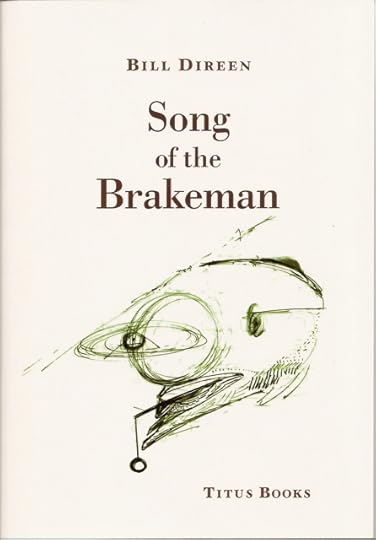
Bill Direen: Song of the Brakeman (2006)
Blurb:
Song of the Brakeman happens in a world where the earth's resources are almost exhausted, the water supplies are contaminated and parts of the landmasses have imploded. But the crisis into which this novel plunges the reader is not only an ecological one. An urban technician and his tribal lover are forced to take sides in a life-or-death struggle between irreconcilable forces: one in possession of the earth's remaining wealth and power, the other carrying the genetic key to the survival of mankind.
Bill Direen has written about a Balkans refugee in Berlin, a coma-victim at a rock concert, and the underbelly of art-obsessed Paris. In Song of the Brakeman a new cast of edgy characters is born to a world heading for extinction.
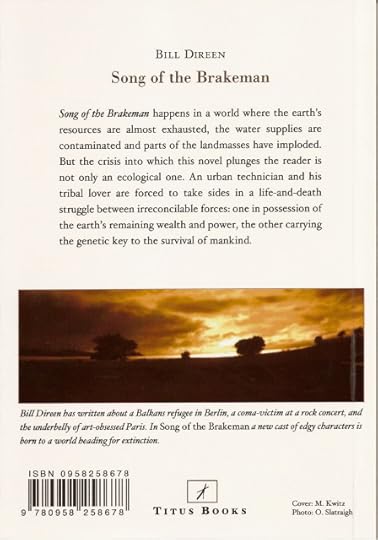
To justify the errors of their machine they sent me for a therapy called Writing. - Bill Direen, Song of the Brakeman (Auckland: Titus Books, 2006): 114.
The blurb above certainly doesn't do justice to the profoundly disturbing nature of William (Bill) Direen's masterpiece, Song of the Brakeman.
Direen is probably more famous, still, as an alt rock musician than as a writer. “Bill Direen is Chris Knox for people who think of Chris Knox as Neil Finn” - as Scott Hamilton once mordantly summarised Direen’s status within New Zealand music. As a solo artist, and with his band The Bilders in all its various manifestations, he's compiled a large back-catalogue of deliberately 'lo-fi' recordings and performances.
His writing career came later, in the late 1990s and early 2000s. You can find an annotated list on his Wikipedia page, as well as in the (selected) bibliography below.
Rather than attempt to characterise his work - in its most extreme form, as manifested in such parts of his œuvre as Song of the Brakeman - it seems easier to quote some examples. Here's a touching anecdote from a conversation his protagonist, the Brakeman, has with a fellow customer in a brothel, early on in the novel:
'It's the month of the partial eclipse. I've lost everything and I'm walking along where my house used to be, looking for anything, a dog collar, a plank of wood painted cosy green. Among those fjords that used to be my suburb there it is, docked between two rocks, a trimaran on stilts. A light is shining from the observation window. I climbs a rock and sees a lean figure, scarlet, part-man, part-woman, piece shining like a diamond. She opens her blouse to another, a two-way him-her, who draws a fiber from her heart and eats it neat. He grows, slow and painful like there's a weight inside him. They mock each other on the slippery decking, spitting in the face, you know, and twining like it ain't, y'know, love, like eels on heat. You seen that?'If that doesn't mean a lot to you, fear not. The foreign inflections of the idioms of our future will fall gradually into focus, until finally you'll wonder why you ever had any trouble with them ... One of the central problems with this future, however, is its insistence on the evils of unrestricted writing. One of the Brakeman's earliest misdeeds is cooking up a batch of ink for his upstairs neighbour, an aristocratic young dancer:
The mercenary's rendition was corn porn, but his trade was his will and testament. He had seen a tribeswoman donating to save one of our boys who, like me, was less than tribal. Galveston had him as beefsteak before World Independence Day. [31]
When she asked me for ink I couldn't refuse, though I knew the danger. Anyone who used that stuff was regarded as an enemy of the state. I perfected the mix that would be the cause of her arrest, a crimson viscous concoction thickened with carbon from the incineration pits. You could do anything with it, old conning peasant dark drivel, government poetry, South Sea journals, delta discoveries, but that monkey bile would darken her manuscript best of all. [24]That list could serve quite nicely as a characterisation of the book itself. All of those things (and more) are to be found within these pages.
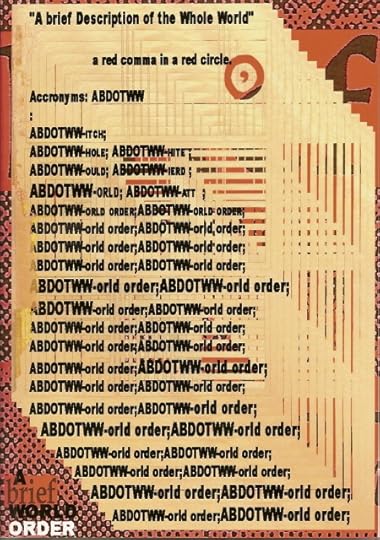
Matt Kelly: Cover Image (2007)
My brother Ken wrote a review of Bill's book in brief #35. In it he commented particularly on this central linguistic aspect of the novel:
The driving, pulsating, often super-elaborate quality of the language was another fascination. Direen can create a new slang in every page. He can involve mystical reasonings, implied comments on the human condition, in what is largely a fast-moving narrative texture. For those who love language for its own sake, this makes for an invigorating ride. Both these additions and the poetical aspirations of the book take it, in fact, outside the bounds of Science Fiction proper. We could say that by a synthesis of directions, Direen has managed to occupy new literary ground. - K. M. Ross, 'Review of Song of the Brakeman.'With due respect to Ken, I'm not quite sure that I agree there. It's true that such violent dislocations of language do seem more designed to evoke Finnegans Wake than (say) The Day of the Triffids (a comparison already made by Scott Hamilton in his launch speech for the book). 'Science Fiction proper' has always been a bit of a difficult beast to taxonomise, however. As Kingsley Amis and Robert Conquest remark in the epigraph to their 1962 anthology Spectrum 2:
brief 35 - A brief world order, ed. Brett Cross (September 2007): 120-21.
'Sf's no good,' they bellow till we're deaf.I'd like, instead, to suggest a few possible analogues:
'But this looks good.' - 'Well then, it's not sf.- Kingsley Amis & Robert Conquest, ed. Spectrum II: A Second Science Fiction Anthology. 1962. Pan Science Fiction (London: Pan Books Ltd., 1965): 4.
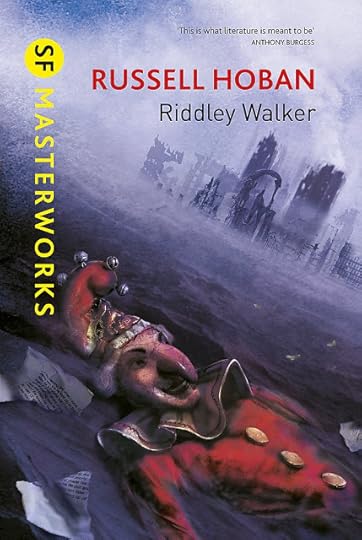
Russell Hoban: Riddley Walker (1980)
The obvious one is with Russell Hoban's classic novel Riddley Walker (1980). Because it's written in a gnomic, riddling style, the fact that this is clearly a piece of SF in the standard understanding of the term - plot-wise, thematically, and in terms of intention - was repeatedly denied by critics who felt that it was too accomplished to deserve the appelation. The generic flexibility of Hoban's other work - from fantasy in The Lion of Boaz-Jachin and Jaachin-Boaz (1973) to the eco-fiction of Turtle Diary (1975) - gave fuel to their argument: somewhat absurdly, in retrospect.
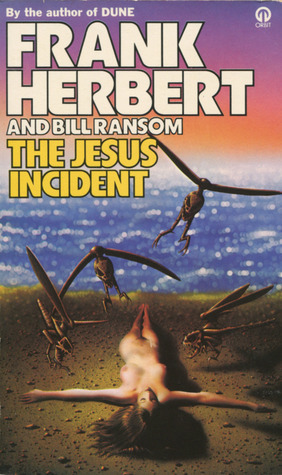
Frank Herbert & Bill Ransom: The Jesus Incident (1979)
I would challenge any reader to go through the first twenty or so pages of the work above and give me an accurate summary of their contents. It takes time for post-new wave SF novels to establish the ground rules both of the cosmos they inhabit and the language in use there. Sometimes it's easy, sometimes (as in this case) extremely challenging. It's something that die-hard fans learn to live with. Non-SF-tempered readers can find it a sore trial, however.
And yet no-one ever proposed the novel above as anything but strict SF, despite its thematic complexity and scope. The same is true of the more conventionally composed Dune (1965), despite its obvious status as one of the most influential novels of the past fifty years (as a pioneering piece of 'planetary ecology', among many other things).
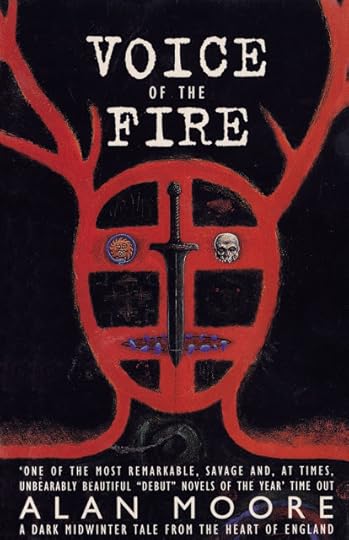
Alan Moore: Voice of the Fire (1996)
My final exhibit is comics-supremo Alan Moore's debut print - as opposed to graphic - novel, Voice of the Fire. The resemblances here with Riddley Walker are strong, despite the prehistoric setting of the first section of his story. This makes it what? Fantasy? Historical fiction? Fantasy-&-SF? In the end, all one can really call it is a singularly ambitious novel, tout court.
And so, without doubt, is Direen's Song of the Brakeman.
Speaking for myself, I found the first fifty or so pages of the book fairly impenetrable on my first run through - after that, however, things settled into a more or less comprehensible narrative. Turning back, however, the first pages seemed no more difficult than the last: it's as if it simply takes that long for Brakeman's language to come into focus - rather like that in use in the memory-less world of Anna Smaill's The Chimes.
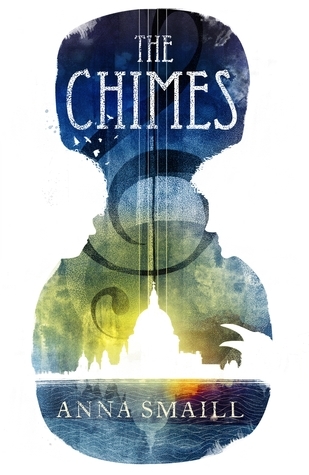
Anna Smaill: The Chimes (2015)
Direen's book is in four sections:
The Yard (pp. 7-98): The Brakeman in his natural state, working to repair the vehicles that roar up and down the broken super-highways of this devastated future world. The start of his love affair with the queen of the rebellion, Enola, and his meeting with the mistress of theory, Myra.
It was twenty five years since the world, or what was left of it, had declared itself one state. The world turned twenty six. The new configuration of the earth's plates was holding. Magnetic lines were settling in to the new order. We were belting through time as before, 365 days a ringband, 67,000 miles an hour, the sun beating through the milky way once every 225 million years. It was eternity as usual ...Pell (pp. 99-179): The Brakeman in prison, tortured within an inch of his life, but finally contriving to escape in a Blackhawk helicopter with Enola, who's been masquerading as a nurse within the facility.
I was afraid to sleep, and afraid not to. I sat up nights watching, waiting. The weather was playing tricks. Cloud was condensing in the yard, dribbling down the walls. It was gray all day, every day. [81]
It had been a long dry, as great a calamity as when the ice caps had melted and the dried-up viscera of the earth had caved in, fragmenting the continents. True water had sunk beneath the petroleum gunge, the dregs of centuries. Underground caves had sucked it way down till it was too deep to bore. Some of the water had returned as steam from volcanic port-holes but it had changed. Its chemical composition was no longer H2O ... A weight, heavy as earth itself, rose above us. [127]
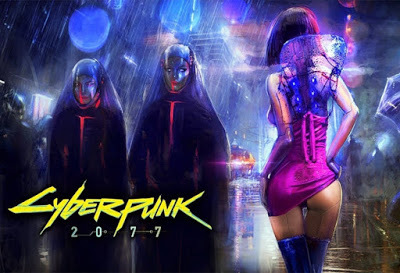
Cyberpunk 2077
The Flood (pp. 181-205): Their subsequent adventures in the viscous soup that passes for the remnants of the world's oceans, in an increasingly dreamlike state, as their son Richie is born and grows into maturity in the space of a few days.
As we penetrated Flood we found that there were areas which did not congeal in the night, and crusted floating masses which did not dissolve during the morning. These merged on contact to form floating islands. Their terrain appeared smooth but was jagged with dangerous crystal blooms. Not all floating objects were dangerous. Some were boons. One floating crate was full of sealed packets of seaweed powder, rich in vitamins. [192]The Tribe (pp. 207-64): The revelations at the heart of the forest, the final battle between Cadena's forces of destruction and the survivors of the tribe: the birth of a new consciousness beyond the alternating forces of life and death.
The chiefs lacked the usual combination of elements, of right and left, male and female. They were formed in a way I had never contemplated. Few of the males had scrotums to speak of and few of their penises had stems - they were knobs of Tyrian purple nosing out of thinning fur. The breasts of those who had them, whom I will call the women, were large. In fact, they were being milked and their primary protein source must have contained some antidote, an ingredient that kept many of the limitless poisons and microbes at bay. The ganglia of many were, nevertheless, tumefied. The necks of some were lymphatic pile-ups, Many had stitch marks where apprentice surgeons had implanted digestive organs. Some displayed evidence of freelance experiments: patches of animal fur, non-human mammalian genitals ineptly implanted. This gave me hope. Where there were surgeons there was some form of anesthesia and stitching thread to retrieve Myra's theory. [225-26]

Jean Wimmerling: Cli-fi (2018)
This last section of Direen's book, in particular, defies easy summary. His prose grows increasingly surrealist and disjointed, till it begins to resemble a strange cross between Angela Carter (the first chapter, in particular, of The Infernal Desire Machines of Doctor Hoffmann - published in the US as The War of Dreams) and the Comte de Lautréamont's visionary Chants de Maldoror.
Mind you, something like this might be expected of a narrator who learned his art in prison, under the watchful eye of his torturers (as well as Enola, his tribal lover disguised as a nurse):
She had a stack of biros and I was soon working with my left hand. Soon we would have a script, a real pot-boiler. Old trash with the hot stink, survival stories, commando raids, jealous killers, androgynous embryo-farming hitchhiking cannibals, city-born unknowing incest pairs, isosceles political love triangles, rebellious impotent pinned entomologists hot for virgins and farmer-savages, heretic self-made execution-rippers caging leper monks and concupiscent boat-boys.More to the point, however, when Brakeman finally reaches the centre of his personal labyrinth, the regions of the tribe, he is separated from Enola and acclimatised to the new conditions by his new he/she lover Xanjal:
Imagining is free, even in three-word strings. [149]
On the fifteenth day we rose from the bed and she guided me through the city. There were two cities, she said, contained in the same space, but she could only show me one. There was no law against looking through the cracks in the temple walls. There were centuries-old icons there, pheasants being roasted over fires of seasoned cherry wood, a priest sprinkling oregano over the flames. In another chapel I saw women being crucified for having failed impossible tasks. I fell back. She laughed at that. She said no one sees other than what is in his or her own mind. She was so like a ghost when we went through the city together, that I asked her if she had ever been in touch with the dead. She said that death returns us to the future. We arrive every moment from the future. When we die we go there eternally. [230-31]"No one sees other than what is in his or her own mind" - is that the final message of Direen's book (insofar as any book needs a 'final message')? Certainly Aleister Crowley's motto (borrowed from Rabelais): 'Do what thou wilt shall be the whole of the law,' appears to be the only rule that applies in this strange multi-layered city / swamp / forest.
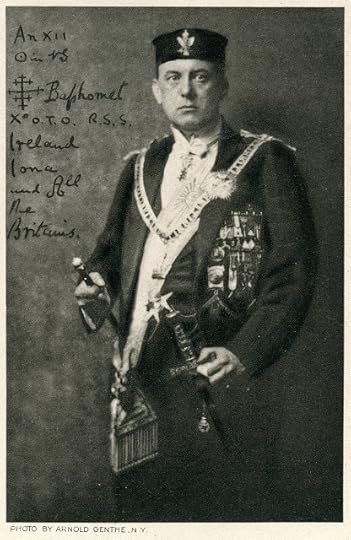
Aleister Crowley (1875-1947)
Another, even stranger influence on his work might be seen elsewhere, in the weird fantasy adventures of Victorian visionary Rider Haggard. Direen's endlessly dying and reviving heroine Enola (named, presumably, for the bomb that spawned all these misadventures and transcendences) reminds one of no-one so much as Haggard's immortal heroine She-who-must-be-obeyed:
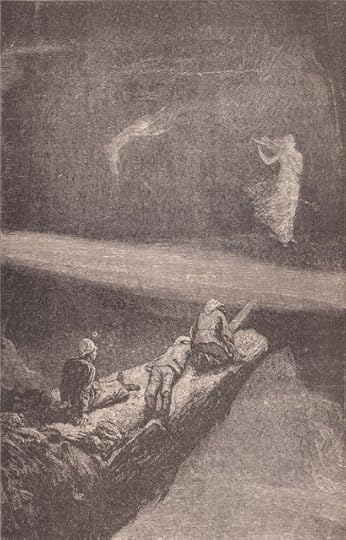
Rider Haggard: She (1887)
And not simply in her first incarnation as the white queen of a cannibal tribe in Africa, but her later, even weirder appearance in the mountains of Tibet, as the reborn Ayesha.
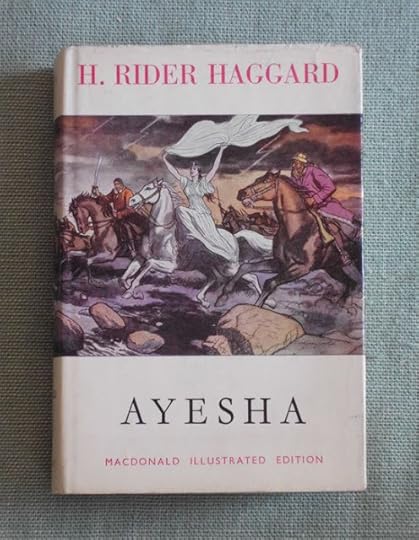
Rider Haggard: Ayesha: The Return of She (1905)
We could continue this allusion-hunting indefinitely, however. I have to admit that I still have many questions about Direen's book, though. Why, for instance, is there a state of John Logie Baird, the Scottish inventor of television, outside the spurious 'voting booth' on p.25? Does he have a place in this future polity akin to that of Henry Ford in Aldous Huxley's Brave New World?
Is the trimaran found by Brakeman and Enola in the swamps of Flood, on p.188, the same as the one described in my first extended quote above, the one where a tribeswoman is seen donating her heart's blood to save 'one of our boys'?
What is the significance of the name 'Richie Tibbetts'? Why is Enola and Ex-P's child called that? The account of his birth and upbringing and the strange sledding expedition to save his mother from a trapper (pp.194-96) is pretty trippy even by the standards of the rest of the book. Is this where the dreamtime really begins?
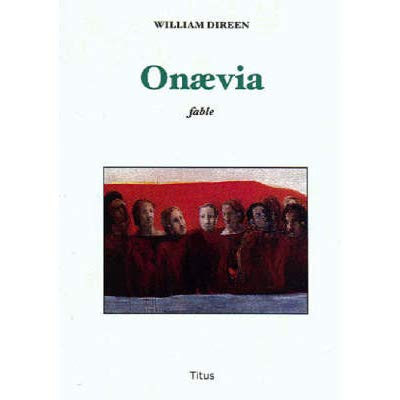
Bill Direen: Onævia (2004)
One obvious source of answers to this and other tantalising mysteries in the book might seem to be this earlier work by Direen, described by him on the SOUTH INDIES TEXT & MUSIC PUBLISHING site as the "invented history of an imaginary land, taking as its lead such masterpieces as Swift's Gulliver's Travels and More's Utopia. It is the first story of an SF sequence that includes Song of the Brakeman, L, and the two parts of Enclosures 'Jonah', and 'The Stadium'."
There is a somewhat more circumstantial blurb on Goodreads:
The nation of Onævia grows and declines on the edge of a vast continent. Games, cuisine, beliefs and unusual practices offer a glimpse of a polymorphic people, from the coronation of the first king to the capture of the last surviving Onævian.In practice, though, even if it is meant to serve as a 'prequel' to Song of the Brakeman, there's little in the strange fabular history of Onævia and its gradual descent into decadence and madness that serves to elucidate the latter work in any obvious way. In fact, the doings of the Boowigs and other descendants of the hunter Ighmut sound more like an exercise in Voltairean satire than the nightmarish, Ballardian headtrip of Brakeman.
There is, however, an intriguing paragraph on the god 'Flood' in the section on mythology in the appendix to Direen's book:
Flood was the fourth child of the second generation. Redundant, you might think, in the sea. But he liked nothing better than to glut himself on the shoreline and coastal plains. He reached his slime-coated needle-toes up, and scooped mouthfuls of soil down into his sieve-like gullet. He rose into the sky making beautiful clouds, before rushing down to have his pleasure of the earth, spreading amorphous over the valleys and plains, gathering huts, animals, soil and inhabitants, before spilling, with his plunder, into the discoloured ocean. - Bill Direen, Onævia: Fable. 2002 (Auckland: Titus Books, 2004): 110.Certainly one can recognise there some of the imagery of (in particular) part three of the later novel. Even if - as is quite probable - there are other anticipations there I've missed, Song of the Brakeman is surely the Huckleberry Finn to Onævia's Tom Sawyer: a sequel so much richer than its original that it must really stand alone.
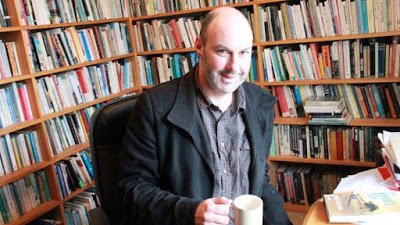
Rose Rees-Owen: Scott Hamilton (2015)
In his launch speech for the book, From First to Fourth Gear, poet and critic Scott Hamilton pointed out the rich heritage Direen's book is drawing on:
The story of Bill's Brakeman also calls up some interesting parallels in the canon of Kiwi literature. One thinks of Lear, a post-apocalypse novel by Mike Johnson ... and The Quiet Earth, the Craig Harrison novel which Geoff Murphy filmed in the '80s. The Quiet Earth showed us the conflict between a Pakeha scientist partially responsible for an experiment that has depopulated the earth, and a Maori who rejects him and his science, and ends up stealing the last girl on earth from him. There is a similar tension in Bill's novel between the Brakeman, a scientist implicated obscurely in the ecological catastrophe that has befallen the earth, and his lover, who belongs to a group of people who live a pre-industrial life. In Song of the Brakeman, as in The Quiet Earth, there is the question whether science and technology are hopelessly implicated in a way of life which has led to apocalypse, or whether they can be made to serve different ends. Can the scientist redeem himself, or must he suffer the same fate as the order he once served?
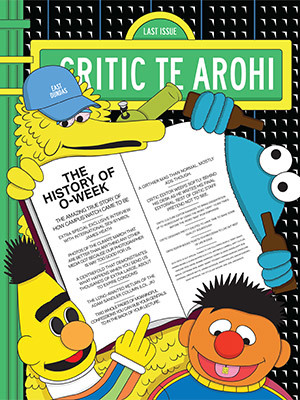
Critic Te Arohi (2019)
In a subsequent interview with Megan Anderson, printed in Otago University's student magazine Critic Te Arohi 7 (2007): 46-7), Direen himself offered some insights into the musical (and political) inspirations for his book:
Song of the Brakeman is set in a world like ours, but it is impossible to treat it as such. The landscape Direen portrays is one in which the continents have fragmented, the environment is irrevocably tainted, the ice caps have melted, and the entire hydrological cycle is suspended. Direen calls it “a world of the imagination, rather than of the future.” This is reassuring, as the world Direen paints is the sort of apocalyptic future one could easily envisage for our own world, if global warming is anything to go by ...That seems as good a place as any to end - or, should I say, in the words of the X-Files, to suspend investigations.
During an interview with the Dunedin-based Bill Direen, Critic got the impression that storyline plays a relatively small role in Direen’s writing ... What’s particularly striking about the novel is its musicality. Direen uses narrative as an expressive tool, constantly altering the narrative’s pace, rhythm and tone to represent what it’s describing. What begins as a choppy, violent urban setting reflected through a film noir / Sin City monologue evolves into a retreat into nature — or what is left of it in a deteriorating world — a lyrical prose flooded with imagery. This performative aspect of Direen’s work is something he is obviously passionate about ... and this is evident in his search for a language which “includes the verbal elements and the musical elements which [are] a part of me, which [have] always been a part of me.” Direen emphasises the sound and musicality of language, rather than focusing on just the semantic qualities of words: “Because I was a musician, and still am” he says, “music and rhythm, and a lot of the musical aspects of language play a big part in the way that I see literature” ...
Direen is adamant that his search for an expressive, musical language is not him “purposely trying to be difficult in this language thing” though he admits, “People have accused me of it” ... The actual song of the Brakeman, sung enthusiastically by Brakeman in the midst of the exceedingly violent interrogation scenes of Part II, is, as Direen says “intended as light relief, really, because of all this heavy stuff.” Direen admits that “It’s a satirical piece, I guess. It’s sort of anti-capitalist.” This makes sense when considering how Direen’s interrogation scenes were influenced by the Guantanamo Bay imprisonments. While Direen refers to America extensively in the novel, he stressed that ‘it’s not anti-American, but obviously I use America as a model for the world state.” ...
At the end of the interview Direen asked Critic of his book, “Did you think it was bizarre?”
Song of the Brakeman bizarre? Perhaps. An absorbing novel regardless? Certainly.
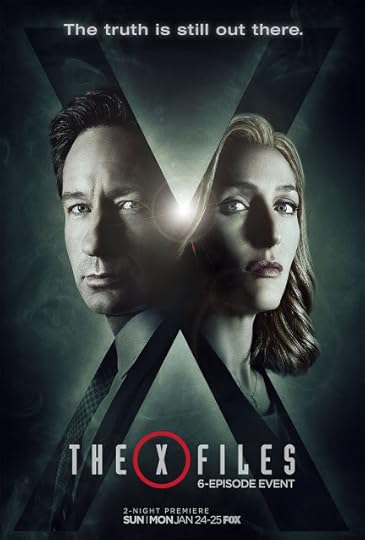
The X-Files (1993-2018)
•
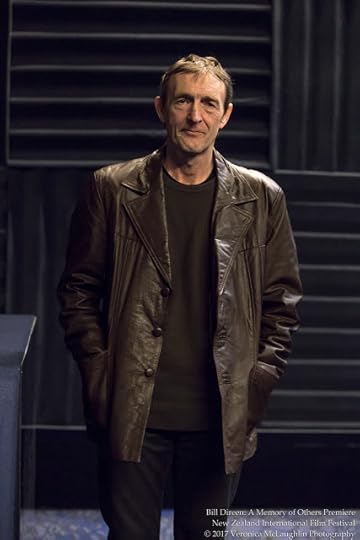
Bill Direen
William (Bill) Direen
(b.1957)
Select Bibliography:
Wormwood: Novel (1997)
The Impossible: Short Stories (2002)
Nusquama: Novel (2002)
Onævia: Fable. 2002. Auckland: Titus Books, 2004.
Jules (2003)
New Sea Land: Poems. Auckland: Titus Books, 2005.
Song of the Brakeman. Auckland: Titus Books, 2006.
Enclosures. Auckland: Titus Books, 2008.
The Ballad of Rue Belliard. Auckland: Titus Books, 2013. [In Brett Cross, ed. brief 48 (June 2013).]
Enclosures 2: Europe, New Zealand; Centre; Stoat: Canal City; Survey. Dunedin: Percutio, 2016.
Enclosures 3: Treatmen(o)t; Scipio Sonn; Nyons-Nice-Venice; Tattoo; from Stoat. Dunedin: in situ, 2017.
Enclosures 4. 2018.
Homepages & Online Information:
Wikipedia entry
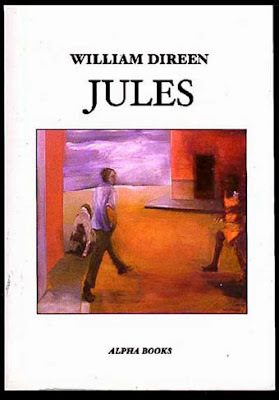
William Direen: Jules (2003)
•
Published on October 18, 2019 12:27
October 11, 2019
Millennials (3): Skylark Lounge (2000)
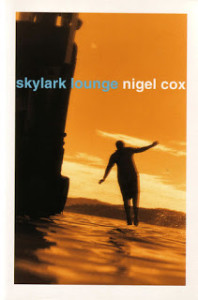
Nigel Cox: Skylark Lounge (2000)
Publisher's Blurb:
In the middle of his life, Jack Grout found himself abducted by aliens. There were other things. His wife left him. His son came one night to the Skylark Lounge - the pool hall Jack bought after throwing in his job in newspaper advertising - and punched him. And there was the mistreatment for melanoma. But what Jack really needed to know was why the aliens, who had first taken him when he was nine years old and shown him his life in unbearably vivid close-up, had returned.
•
Nigel CoxOkay, I wrote this one – the novel I mean, as well as this review. And I bet that within ten years no-one will ever look at this review, so let’s just say it’s the greatest novel since War And Peace. Well, nearly. Actually, it was very well reviewed – one “the biggest book of the year” – honest! – and one “one of the year’s very best” and “from this unusual material Cox has mined a little gold,” plus, “Once Cox would have been called visionary” and other cheering stuff. Dodgy sales, but you get that – it WAS a serious novel that included an encounter with aliens. I was happy. What I liked was that the reviewers liked what I liked about it, which is that its narrator, Jack, is an ordinary man. In my opinion this is the hardest thing to write, an ordinary person who has a job and a family and is not over-intelligent but no fool either – and who isn’t depressed or depressing or boring, but can give you (this is my idea, but several of the reviewers picked up on it) a sense of the wonder of being in the world. Okay, that’s all I think I want to say: it’s a weird thing to do, this, kind of like an advertisement for yourself. But no-one will ever read it, except you maybe.
1.0 out of 5 stars
Who on earth will ever read this?
February 15, 2004
Format: Paperback
Nigel Cox, Berlin.
Yes, this is indeed Nigel Cox's own Amazon.com review of his 2000 novel Skylark Lounge. He'd published two earlier novels, Waiting for Einstein (1984) and Dirty Work (1987), over a decade before, and this was his big come-back title.
He'd spent much of the time between Dirty Work and Skylark Lounge working as a senior writer at Te Papa - a theme which leaks into Skylark Lounge. The hero's wife Shelley has basically the same job.
Shortly after the publication of Skylark Lounge Cox left New Zealand for Germany, where he took up a job as Head of Communication and Interpretation at the Jewish Museum, Berlin.
Looking at the recorded time (February 15, 2004) and place (Berlin) of the comment above, it must have been composed a year or so before his return to New Zealand in March 2005.
Nigel Cox died of cancer on 28 July 2006. His Wikipedia entry says that it's something he'd 'been battling for some time' - so perhaps that was one of the motivations for writing such an online cri-de-coeur.
Clearly he didn't think that the book - or his whole body of work, for that matter - had been given its due. So far as I can see, there are no such messages on Amazon.com about any of his other titles. Perhaps it was the neglect of this one in particular that really galled him.
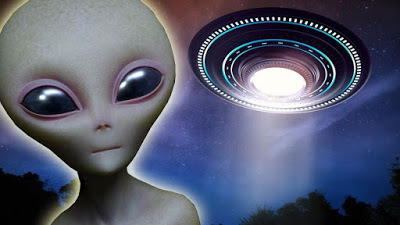
What is Area 51?
Skylark Lounge is a novel about aliens. The main character, Jack Grout, had some encounters as a child, but when the aliens rediscover him again in the middle of a road just outside Wellington, his carefully constructed life begins gradually to unravel.
Recently, after a cancer scare, Jack quit his job and bought a pool hall, the eponymous 'Skylark Lounge,' which he runs as a haven of peace and quiet for the beleaguered wage slaves of the city.
All of this is threatened by the return of the aliens. They don't manifest in flying saucers; neither do they look like 'Greys' or any of the other familiar images from contemporary Abduction mythology. In fact, as we learn at the end of the novel, they are so microscopically small as to be virtually undetectable by human senses.
Their dilemma is that they tend to become anything that they pay undue attention to, so Earth, and humans, are maintained by them largely as a museum of Otherness. There's a small cadre of people they call on from time to time - a few thousands from among the millions - and Jack, it would appear, is one of these.
As Cox says above:
What I liked ... is that its narrator, Jack, is an ordinary man. In my opinion this is the hardest thing to write, an ordinary person who has a job and a family and is not over-intelligent but no fool either – and who isn’t depressed or depressing or boring, but can give you (this is my idea, but several of the reviewers picked up on it) a sense of the wonder of being in the world.It's tempting to regard the 'alien' plot as entirely metaphoric: simply a device for pointing out the wonder of 'ordinariness' by depicting its opposite. However, the careful attention Cox has paid to the mechanics of Jack's visions makes them sound more like Thomas Traherne's ecstatic prose-poetry than a kitchen-sink drama:
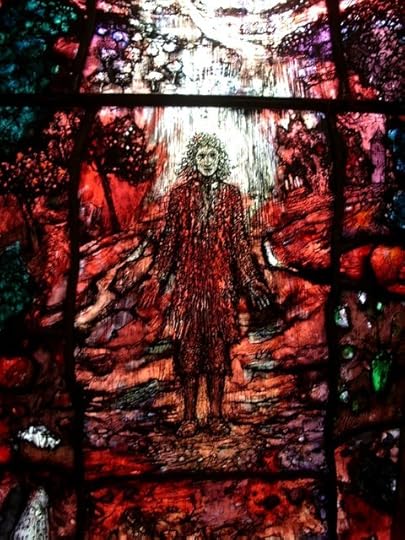
Tom Denny: Traherne Window (2007)
The corn was orient and immortal wheat, which never should be reaped, nor was ever sown. I thought it had stood from everlasting to everlasting.That's the quote - from Trahern's Centuries of Meditation (c.1674) - which everyone's so familiar with. Compare it to Cox's:
My hand touched a table. There was no boundary between the table and me. What a slow life the wood had. In that life all the past was present - the factory where the table had been built, the log from which it had been cut, the earth where it had grown.And then there's this from Traherne:
So nothing is lost. [142]
The Men! O what venerable and reverend creatures did the aged seem! Immortal Cherubims! And young men glittering and sparkling Angels, and maids strange seraphic pieces of life and beauty! Boys and girls tumbling in the street, and playing, were moving jewels. I knew not that they were born or should die; But all things abided eternally as they were in their proper places.Compare it to Cox's:
We'd come often to Pukerua when I was a kid. Great hook of bay. Immense eyeball of ocean, with seabirds flying long lines across it. Blue-green island long on the horizon, looking like Te Rauparaha's mere that I saw in Te Papa. In the foreground, the rock pools where we poddled, shrimping with milk bottles, prising limpets. [19]or this (from the account of Jack Grout's first 'abduction' experience):
And the world itself was wonderful too - the astonishing diversity of it, and all of it so busy and alive. Even the dead bits like the rocks - they seemed to be sort of humming. As I went higher I could see the coast curving away to the north, and then the outline of the southern end of the island, and finally I could see the whole North Island ... I can't tell you how much I loved the North Island. The shape of it. [24]
•
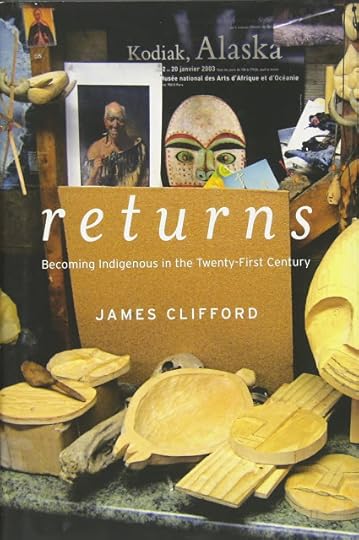
James Clifford: Returns (2013)
Recently a friend sent me a copy of this book about the concept of 'indigeneity' in the 21st century. I found it fascinating on many levels, but was particularly struck by the quotation below, towards the end of the final essay:
A more common "long-view" of history you hear when talking to Natives in rural Alaska is that the coming of the whites and all their technology was something long foretold by shamans and so on. Televisions and airplanes in particular were long foretold. This summer in [the Yup'ik town] Quinhagak I heard a new twist on this in that the little people (who appear now and again to people throughout the circumpolar world) used to appear to their ancestors wearing 20th century clothing and even sitting on tiny versions of 4-wheelers when confronting their 19th century ancestors, because little people have the ability to travel back and forth through time. But if prophesies exist, they don't seem to address what the end-game will be, or if this slow-motion train wreck of contact will continue forever. Or maybe people are just too polite to bring that up.I love that idea of the little people manifesting on four-wheelers, with contemporary clothes, to the distant ancestors - because time means something quite different to them than it does to us.
- Archaeologist Richard ('Rick') Knecht, quoted in Returns: Becoming Indigenous in the Twenty-First Century, by James Clifford (Cambridge, Mass: Harvard University Press, 2013): 318.
There's something of that paradoxical, dislocating nature in Cox's book, also:
I don't believe in synchronicity - as far as I'm concerned, a coincidence is a coincidence. It's important that I get this clear: I don't believe in fairies at the bottom of the garden. Because what I am going to get down in these pages will cast that into doubt. [11]The mention of 'synchronicity' gives us a cue, however. Synchronicity, as you're no doubt aware, is a concept of Carl Jung's, designed to 'account for' the seemingly meaningful webs of coincidences that surround us all.
There's something of self-indulgent double-talk about it, as well as something of wisdom (like so much of Jung's thought), but the point is that it leads us naturally to his classic work on Flying Saucers. This long, late essays really put paid to any remaining scientific credibility he may have had - a bit like Freud's final thoughts on Moses and Monotheism - but it remains a small masterpiece of inductive logic.
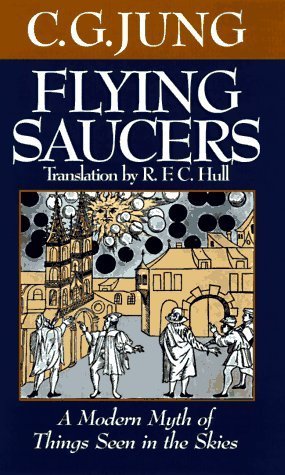
C. G. Jung: Flying Saucers: A Modern Myth of Things Seen in the Sky (1959)
Jung, Carl Gustav. Flying Saucers: A Modern Myth of Things Seen in the Sky. Trans. R. F. C. Hull. 1959. London & Henley: Routledge and Kegan Paul, 1977.
... the problem of the Ufos is, as you rightly say, a very fascinating one, but it is as puzzling as it is fascinating; since, in spite of all observations I know of, there is no certainty about their very nature. On the other side, there is an overwhelming material pointing to their legendary or mythological aspect. As a matter of fact the psychological aspect is so impressive, that one almost must regret that the Ufos seem to be real after all. I have followed up the literature as much as possible and it looks to me as if something were seen and even confirmed by radar, but nobody knows exactly what is seen. In consideration of the psychological aspect of the phenomenon I have written a booklet about it, which is soon to appear. It is also in the process of being translated into English.- C. G. Jung, Letter to Gilbert A. Harrison, editor of The New Republic (December 12th, 1957)Jung's point about the flying saucers is that it doesn't really matter - from the psychological standpoint, at any rate - whether they're 'really there' or not. What interests him is the way in which they infiltrated the imaginations of modern people, immediately after the Second World War, most of whom had denied themselves the release of conventional religious systems (and therefore conventional iconography).
Where an earlier generation would have seen angels and demons, these 'Moderns' saw visions which matched their materialist, scientific world-view: spaceships, and aliens from other planets, and such-like 'possible' manifestations to symbolise their underlying fears and anxieties.
Jung's essay concentrates on dream interpretation, and makes an excellent job of persuading readers that this imagery is only to be expected, given contemporary belief systems and material conditions - not to mention the overwhelming terrors of the (then) brand-new atomic bomb. Never had there been more cogent reasons for fear in the whole previous history of the human race. And this is how it declared itself.
Fiction writers, too, must deal with a world where the truth of what they say is always at a remove. The close attention paid to details of landscape and setting in Skylark Lounge - its intersection (presumably) with details from the author's own life - doesn't alter the fact that everything it is saying is to be taken metaphorically.
Are the 'aliens' meant to be real, in context? It doesn't matter. One could easily read the book either way. Even if Nigel Cox were a zealot for UFOlogy, and had written his novel as a contribution to the cause, it would still be the effect of these beliefs on his character - the things that could be said in this manner - which would actually matter to him.
Shelley is the only writer I've ever heard of who doesn't feel she should be writing a novel. She doesn't leave poems, or bits of poems, around the place on scraps of paper or in the margins of books. She's not an artist. She writes good clear prose, she says, and semi-snappy headlines, and she always hits her deadlines. She doesn't stay up late agonising. [51]Cox's main character certainly doesn't see himself as an artist. The proposed genealogy for the book we are reading is that it was all scribbled in exercise books in a motel in Waiouru shortly before his fateful last encounter with the aliens.
He is, of course, in practice, a hell of a writer - because Cox himself was - but then the same would have to be said of Mark Twain's mouthpiece Huckleberry Finn. Could an illiterate boy really write as resonantly and clearly as that? Of course not. But the tone must sound plausibly his for the writing to succeed at all. The same consideration applies to Jack Grout.
And, since Jack survives this final encounter (sorry for the plot-spoiler), we can imagine a final tidying-up of the manuscript - if not a careful reworking over time of the rough first draft - by him, or even by Shelley (if she ever works her way round to forgiving him).
•
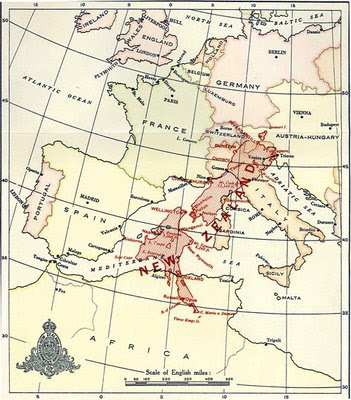
NZ Official Yearbook (1919)
For many years I co-taught a postgraduate course with the catchy title Contemporary New Zealand Writers in an International Context - a bit of a mouthful, certainly.
I suppose the reason for the clunky title was that we didn't want students to be surprised by what they encountered there. There certainly used to be a certain apartheid about literature courses here. 'Local' writers go in through that door - the old shabby one, just past the manuka hedge and the septic tank - and 'international' writers are ushered in through the space-age one covered with zinc, with a big red carpet leading up to it.
The average New Zealand literature class would begin with something along the lines of: "I was talking to Karl Stead the other day, and he said that Ronald Hugh Morriesson once told him that ..." Oodles of name-dropping and regional colour and only the occasional lapse into actual lit crit. I say it who know. I'm as guilty of all that as the next man ('Kendrick once said to me ...' 'I was having tea with Paula Green and she mentioned that ...')
The idea of this one was to compare prominent works by local authors with analogous 'international' texts, and to point out - all appearances to the contrary - that we don't live on an island intellectually and creatively, however far away we may be geographically from everyone else.
One of the texts we taught was Nigel Cox's Dirty Work (1987), and on one occasion his widow came to talk to the class - and us - about his work. I was the poetry person in the course, while my colleague Mary Paul handled the fiction, but I guess if I'd been trying to find a good analogue to Skylark Lounge (which would have been my first choice, much though I do admire Dirty Work), I might have come up with something like this:
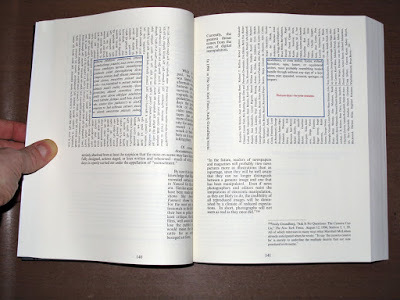
Mark Z. Danielewski: House of Leaves (2000)
Those of you who've read it - or even heard of it - will know that Danielewski's debut novel is designed to screw with your head. The typography is odd, the story baffling, the implications quite terrifying - it's one of those stories, like Ring or Videodrome, where even encountering the outer levels of the mystery is enough to doom you to a fearful end. I suppose that's why it was so surprising that it became a runaway bestseller.
The same could not be said for any of Danielewski's subsequent works, which I have to say I found it impossible to make heads or tails of. This one, though, is a classical ghost story, despite all its frills and trimmings. In the same sense, Skylark Lounge is a classical UFO tale. Cox's economy of means is far more profoundly considered, however, which might even lead some readers to see it as throwaway.

Elizabeth Knox.com
Not so Elizabeth Knox. Recently she posted quite a long essay about the novel on her website, in which she made it clear that it was one of her favourites among his works. I won't quote too much of it (you can read it for yourself), but there are a few points she raises which I feel should be mentioned here:
Skylark Lounge is a book by someone who didn’t want to write a “kind” of book; a book with a defensible territory. It is not coincidental that its protagonist’s name is Jack Grout. Grout isn’t what sticks tiles to a wall, it’s what joins the tiles, and seals those joins. Skylark Lounge doesn’t have a single setting ... or a milieu. It has irises that open on its many scenes, a pool hall, a marriage bed, a back porch, a kitchen table in the Grout house, a tennis court, the surface of the moon, a Waiouru Motel.That's very nicely put, I think - and ties in very well with that comment of Cox's I quoted above (and which I first came across as a link on the thread inspired by Knox's article). The fact that it clearly came as news to her, as well as to me, makes the coincidence an even more striking one:
Skylark Lounge is a novel about a middle-aged man having a crisis because the alien abductors of the most ecstatic period of his childhood return, bringing their alienating ecstasies. ... The reader squirms with Jack as he tries to avoid telling his family why he’s off – off by himself, off at odd hours, off in his behaviour. And it cleverly incorporates into the story why Jack’s family at first offers him such latitude with his crisis. He’s recently had a brush with cancer, fruitless scans, and a course of chemo. By putting the cancer alongside the aliens as what might be going on with Jack, Nigel avoids the possibility that the metaphorical scope of his book will be reduced to the aliens representing cancer. I have heard Skylark Lounge discussed that way, and I remember that the first time I read it, with Nigel’s melanoma’s first appearance so fresh in my mind, I was happy to accept the idea that the aliens were a metaphor for cancer (as well as being real science fiction) and that this was a way Nigel had found to write about his illness ...If the book's so metaphoric of the richness of 'ordinary' life, it is tempting to reduce it to a long meditation on the fact of just having been diagnosed with cancer. But if one contents oneself with saying it's 'only' that, it does reduce the significance of the book somewhat - makes it more strictly personal than I think Cox meant it to be.
Reading the novel now, at fifty-seven, a year older than Nigel was when he died, I can still see the aliens as aliens – as character and plot. And I can still see them is something of a metaphor for cancer. Or for the interruption of life by fear of death, which throws us back on life. But now I can see whole new strata of meanings, and a book I always admired and considered intellectually and emotionally deep has flowered further in my understanding.What a coincidence! I'm 56 - due to turn 57 next month. I hadn't realised that that was Nigell Cox's age when he died. There is a certain sense, though, in which certain things come into focus as one gets older - parts even of long-favourite books begin to take on new resonance.
It seems to me now that Skylark Lounge is also a book written by someone who had, at some points in his life, a very real fear of losing his mind. I recognise this partly because between 2000, when I first read the novel, and 2006 when he died, I learned a lot more about Nigel.So it's about cancer, and mental illness, and ordinariness, and - everything really. But there's one last aspect of it, too:
Another thought I had about Jack Grout’s having been press-ganged into the job of revealing human life to aliens, and his pressing need to understand what all that actually means, is that this is the writing life. The fiction-writing life. Jack’s aliens make him go off on his own, make him secretive, vague and cold to his friends and family. Jack’s aliens are an enemy of family life, and the reliably ticking-over everyday. They put thoughts into Jack’s head that no one else can see or hear. They torture him with immanence, with things that have to be solved, with the tantalising, unsettled shimmer of a great pattern. Jack Grout’s aliens are isolating and marvellous, and they do his head in. They are the writing life. They pass through – like novels – leaving him to say, “I’m back. Sorry I was absent. I’ve had enough out, please take me back in.”That's a very writerly thought. As a fellow (albeit far more obscure) fiction-writer myself, I can see the metaphor of 'invasion by outside forces' in this way - as well as empathising strongly with Cox's sense of the neglect of this, his strongest statement to date on the simple mystery of being alive.
I guess where it takes me for my own last statement on the novel is somewhere nearer to an experience I think is available to all of us, albeit in different forms according to our own predispositions. Writers (such as Knox) might see it as inspiration; ecstatic contemplatives (such as Traherne) as visions bearing on the nature of God; Shamans as the various stages on their own interior journey.
That last is the model I think fits best with my own experience of the novel. I note the tendency for imagery of dismemberment and reassembly in accounts of the Shaman's journey to the Otherworld. I note, too, the tendency of Shamans in many cultures to embrace transsexual and culturally dissonant lifestyles.
These do seem to be the experiences (and temptations) endured by Jack Grout at the various stages of his own visionary journey. His final manifestation as a cowboy, outfitted in the tourist shops of Waiouru, commencing his long trajectory home to Wellington, would certainly seem guaranteed to disconcert, at the very least, the people awaiting him:
I'll get out my thumb. Head south. One look at Shelley's face will tell the whole story. [190]
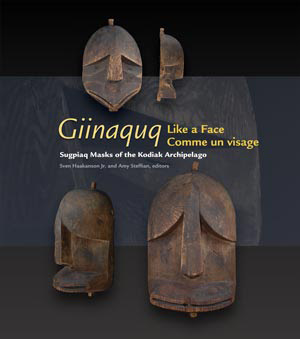
Giinaquq: Like a Face / Comme un visage (2009)
Unnuyauk / Night Traveler'Spirit helper' was originally transliterated, in 1871, as 'дьявол' [d'yavol] (Russian for 'devil'). Alphonse Pinart, the original collector of these masks, translated this as 'esprit' (French: 'spirit'). The new translators have rendered the Alutiiq word ikayuqa as 'spirit helper' - the original meaning is, however, is inaccessible. [297-98].
Why is it my spirit helper, why is it you are apprehensive of me
on the seal rocks?
I will bring you game to be caught.
I went through the inside of the universe;
my helper, that one made me afraid.
I went down where they are motioning.
- from 'Second Life: The Return of the Masks', Returns: Becoming Indigenous in the Twenty-First Century, by James Clifford (Cambridge, Mass: Harvard University Press, 2013): 290.
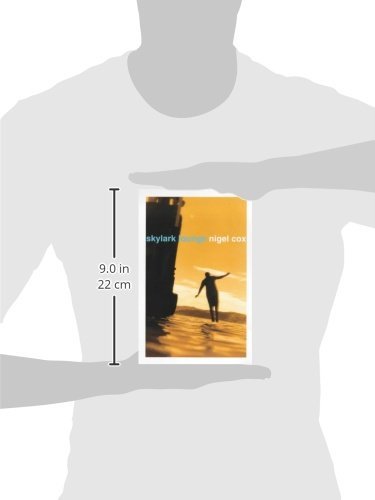
•

Nigel Cox
Nigel Cox
(1951-2006)
Select Bibliography:
Waiting for Einstein. Auckland: Benton Ross Publishers Ltd., 1984.
Dirty Work. Auckland: Benton Ross Publishers Ltd., 1987.
Dirty Work. 1987. Wellington: Victoria University Press, 2006.
Skylark Lounge. Wellington: Victoria University Press, 2000.
Tarzan Presley. [Reprinted as 'Jungle Rock Blues', 2011]. Wellington: Victoria University Press, 2004.
Responsibility. Wellington: Victoria University Press, 2005
The Cowboy Dog. Wellington: Victoria University Press, 2006.
Phone Home Berlin: Collected Non-fiction. Wellington: Victoria University Press, 2007.
Secondary Literature:
Elizabeth Knox. "Nigel Cox’s Skylark Lounge." Elizabeth Knox website (27/7/16).
Homepages & Online Information:
Wikipedia entry
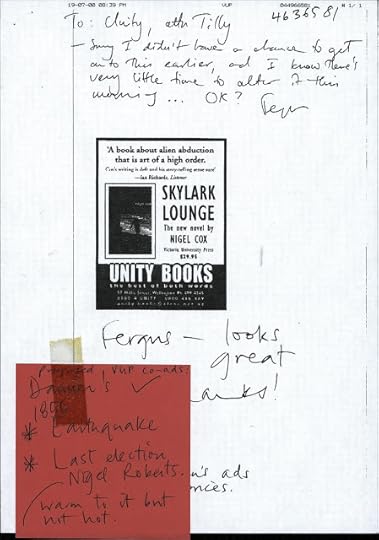
Unity Books: Skylark Lounge advertisement (19th July 2000)
•
Published on October 11, 2019 15:15
October 6, 2019
Millennials (2): Dylan Horrocks' Hicksville (1998)
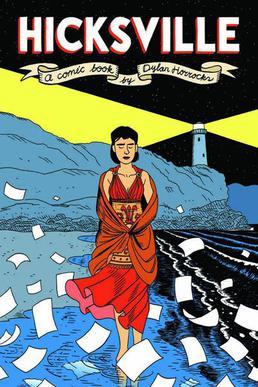
Dylan Horrocks: Hicksville (1998 / 2010)
Is Dylan Horrocks' Hicksville the Great New Zealand Novel?
That sounds like a facetious question, but it isn't meant as one.
This 'Great [...] Novel' idea stems, of course, from all the palaver about the 'Great American Novel.' Is there such a thing? Certainly there have been many attempts to write it, and many somewhat premature advertisements for its appearance: The Great Gatsby, Of Time and the River, Gravity's Rainbow - show me a great American writer, and I'll show you their entry for the elusive prize.
The problem, of course, is that the actual Great American Novel was written long before the idea gained currency. Or one of them had been, at any rate. Personally, I would argue that there are two. The term came (according to Wikipedia) from an 1868 essay by Civil War novelist John William De Forest.
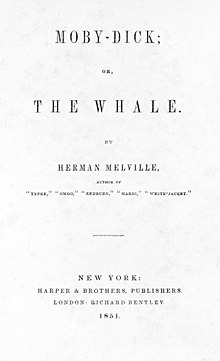
Herman Melville: Moby-Dick (1851)
Candidate 1 has to be Herman Melville's Moby-Dick (1851). Among all the 19 claimants listed on Wikipedia, only this one has the necessary critical heft to have survived all the winds of fashion and the warring schools of interpretation to sail on majestically into the sunset.
It's an impenetrable, Mandarin text, written by an Easterner - a New Yorker, in fact - which is also a great adventure story spanning the world - not to mention all the depths and shallows of the Atlantic and Pacific Oceans. It embodies paradox - is readable and unreadable at the same time - combines libraries of quotations with poignant accounts of the simplest human interactions.
Many people don't get the point of the first, most famous sentence of the story: "Call me Ishmael." This doesn't meant that the narrator's name actually is 'Ishmael', or even that he's adopted that as a useful nom-de-plume (like 'Mark Twain' for Samuel Clemens, for instance). It means that he is a wanderer upon the Earth, like Ishmael the eldest son of Abraham - in contrast to Isaac, Abraham's younger (but legitimate) son by his wife Sarah, the patriarch of the twelve tribes of Israel.
To a contemporary, 1850s, Bible-soaked reader this would have been so obvious that Melville doesn't even trouble to explain it. We are forced to refer to the narrator as 'Ishmael' for convenience's sake, but it's a description of character, not (strictly) a piece of nomenclature.
You see what I mean? Moby-Dick invites such speculations simply because of the oddball way in which it was written. Leslie Fiedler could cause a furore in the 1960s simply by suggesting that Queequeg and 'Ishmael' really are making love in the first chapter of the books - rather than simply lying together chastely like chums. And once you've thought that unthinkable thought, it opens up a whole serious of new perspectives on the novel (cf. Fiedler's Love and Death in the American Novel).
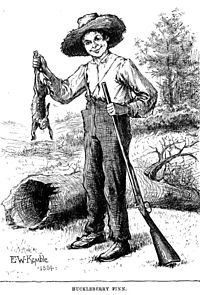
Mark Twain: Huckleberry Finn (1884)
The real problem arises from the almost equal and opposite claims of Mark Twain's masterpiece Huckleberry Finn, which has to be Candidate 2.
Emerson, Longfellow, Lowell, Holmes - I knew them all and all the rest of our sages, poets, seers, critics, humorists; they were like one another and like other literary men; but Clemens was sole, incomparable, the Lincoln of our literature.So intoned William Dean Howells at the end of his long elegiac volume My Mark Twain (1910). Ernest Hemingway put it more simply (and quotably), in The Green Hills of Africa (1935):
All modern American literature comes from one book by Mark Twain called Huckleberry Finn. If you read it you must stop where the Nigger Jim is stolen from the boys. That is the real end. The rest is just cheating. But it’s the best book we’ve had. All American writing comes from that. There was nothing before. There has been nothing as good since.The book grows and grows in its implications - with all its admitted faults - on repeated rereadings. It's hard to imagine any book so embodying the spirit of a country, or (at any rate) the spirit of both the old South and the advancing frontier.
If that isn't the Great American Novel, what is? 'There's been nothing as good since,' is the simple truth, for all the greatness of Faulkner, Fitzgerald, Hemingway himself, Toni Morrison, and all the other great novelists who have flourished on those 'dark fields of the Republic,' that shopsoiled 'green breast of the New World' (to quote The Great Gatsby).
It comes down to one of those classic oppositions: Dostoevsky or Tolstoy? Schiller or Goethe? Wordsworth or Coleridge? One would like to answer all of them with the formula: "Both - and ..." - yet it must be admitted that a sneaking preference always creeps in.
There's always one of the two whom your hand brings down more enthusiastically from the bookshelf. Sometimes it's a simple classical / romantic face-off (Tolstoy and Dostoevsky, for instance) - but such is the complexity of each of their bodies of work, that it never resolves entirely to that.
Jane Austen / Charlotte Brontë would be another, I suppose - or Lady Murasaki / Sei Shōnagon. After a while they dissolve into triads, then groups, then just the whole spectrum of colours and shades of expression ...
Mark Twain and/or Herman Melville, then, is the best I can do for that elusive entity (or should I say chimera?), the author of the Great American Novel. It's a pretty magnificent choice to be confronted by, however!
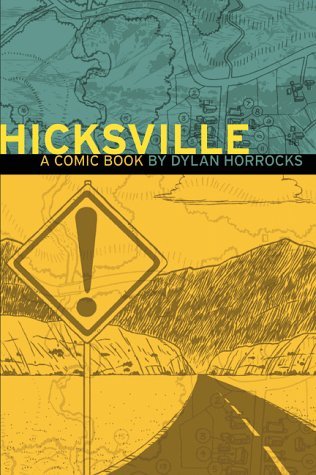
Dylan Horrocks: Hicksville (1998)
Once before I've asked this question about the Great New Zealand novel. My answer then was a bit facetious, much though I admire the intricacies of Chris Kraus's I Love Dick (1997).
Hicksville, to me, seems to present far more solid claims. In his original article, William DeForest defined the Great American novel as "the picture of the ordinary emotions and manners of American existence." He went on to say:
"Is it time?" the benighted people in the earthen jars or commonplace life are asking. And with no intention of being disagreeable, but rather with sympathetic sorrow, we answer, "Wait." At least we fear that such ought to be our answer. This task of painting the American soul within the framework of a novel has seldom been attempted, and has never been accomplished further than very partially — in the production of a few outlines.
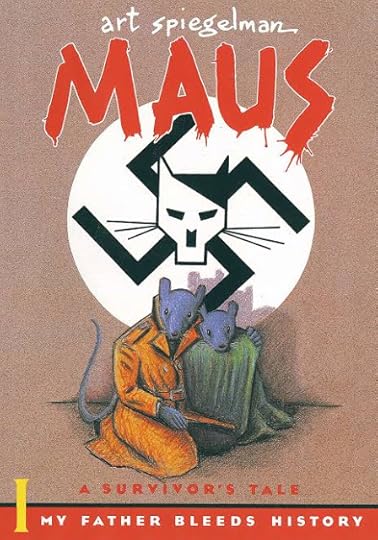
Art Spiegelman: Maus (1980-1991)
I'm sure that Dylan Horrocks had no such lofty intentions when he set out to create Hicksville. From what I gather, it came together from bits and pieces, written and drawn at various times, very much in the mode of his great contemporary Art Spiegelman's Maus , which first appeared, piecemeal, chapter by chapter, in Raw (1980-1991), the comics magazine he co-founded with his wife Françoise Mouly.
The first volume of Maus, 'My Father Bleeds History,' appeared in book-form in 1986, the year of the great graphic novel explosion. It was one of the three groundbreaking works which appeared during 1986-87 to confound dismissive critics (as chronicled in Douglas Wolk's 2007 book Reading Comics: How Graphic Novels Work and What They Mean).
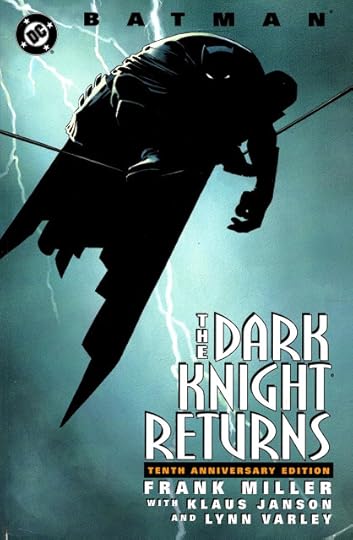
Frank Miller: The Dark Knight Returns (1986)
They were (in no particular order), Spiegelman's Maus: A Survivor's Tale, Frank Miller's The Dark Knight Returns , and Alan Moore's Watchmen .
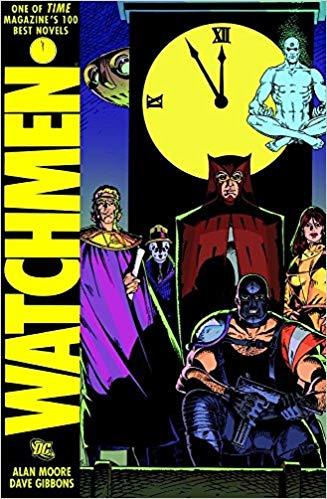
Alan Moore & Dave Gibbons: Watchmen (1986)
I suppose if you live in a cave you might have avoided encountering any of these classic works. The film of Watchmen (in its various versions) is more illustrator Dave Gibbons' gig than Alan Moore's - it left out one of the graphic novel's crucial subplots - although an animated version of this, a pirate story, was released separately. It's a critique of superhero comics (as Don Quixote is a critique of novels of chivalry), but that's only one of the many things it does.
The Dark Knight Returns is only loosely connected - more on a thematic than a plot level - with Christopher Nolan's 'Batman' film trilogy, though it's hard to imagine the latter existing without the former. It's the most conventional of the three, though Frank Miller's subsequent projects 300 and Sin City show that he, too, is a creative force to be reckoned with.
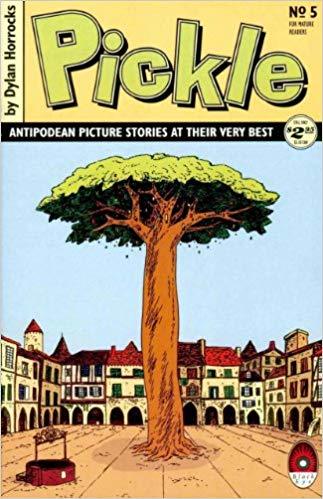
Dylan Horrocks, ed.: Pickle (1993-1997)
The second volume of Spiegelman's Maus, 'And Here My Troubles Began,' appeared in 1991. Dylan Horrock's Hicksville began to be serialised in the second volume of his magazine Pickle, devoted to 'the finest in New Zealand comics', in 1993.
When I met Dylan Horrocks at the 2018 Manawatu Writers' Festival, he told me that in many ways he still considered that the best way to read the novel: in its original serialised form, surrounded by other comics, and all the other contextualising bits and pieces by him and other artists which had to be edited out in book form.
I tried to explain to him something of what Hicksville had meant to me when I first read it in the late 1990s (I was late to Pickle, unfortunately, though I certainly followed his Milo's Week strip comic which ran in the NZ Listener between 1995 and 1997).
Hicksville was an achievement of another order, however. And - much though I enjoyed its follow-up, Sam Zabel and the Magic Pen (2014), it couldn't really be said to have quite the same heft. But then, the same could easily be said of Twain and Melville's follow-up books: respectively, A Connecticut Yankee in King Arthur's Court (1889), and Pierre, or the Ambiguities (1852)).
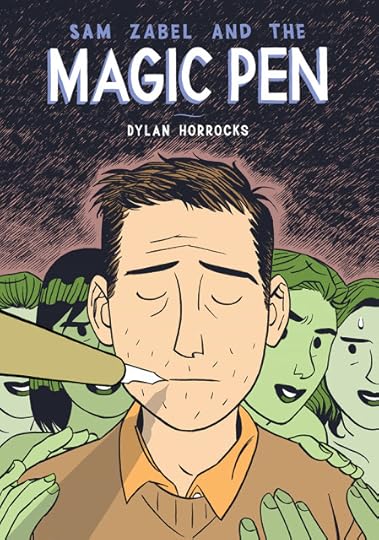
Dylan Horrocks: Sam Zabel and the Magic Pen (2014)
So what did speak to me so powerfully in Hicksville? First of all, it was a piece of identity literature: intimately bound up with the problem of what it is to be a Pākehā New Zealander - stuck in what seems to be the wrong hemisphere, with the wrong cultural conditioning, and yet with an increasingly powerful sense of place and identity.
The strip comic with Captain Cook, Charles Heaphy and Hone Heke included at various points in the narrative gives a perfect metaphor for this sense of cultural drift - not quite knowing where you are, but engaged - consciously or unconsciously - in learning how not to worry too much about the fact.
There are nice vignettes of exile, too: strip comics drawn on the kitchen table in a London flat, side-trips to Eastern European countries to pick up on their own complex comics traditions - not to mention Sam's phantasmagorical journey to Hollywood to see the world of his alter-ego / nemesis Dick Burger close-up ...
Above all, Hicksville is a comic obsessed with comics. Everyone in the imaginary town of Hicksville, set on the tip of East Cape, reads comics all the time, and is intimately knowledgeable of their strange, compromised history: caught between the devil of commercialism and the deep sea of unfettered artistic experimentation.
And then there's that Name of the Rose-like secret library of manuscript and limited edition comics, including the greatest works of the greatest creators, the ones that they longed to write, but somehow never managed to, stored in the old lighthouse on the point, watched over by the enigmatic Kupe.
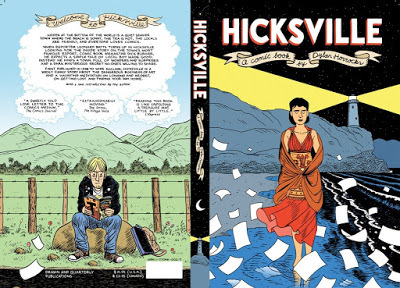
Dylan Horrocks: Hicksville (1998 / 2010)
Into this situation comes Leonard Batts, an American comics journalist, author of a biography of Jack Kirby, who is investigating the latest comics sensation, Dick Burger, by paying a visit to his mysterious Antipodean hometown. (I don't know if the resemblance between his name and that of Leonard Bast, the hapless victim of class snobbery in E. M. Forster's Howards End (1910), is intentional or not, but given the general level of erudition in Dylan Horrocks' work, it wouldn't surprise me at all ...)
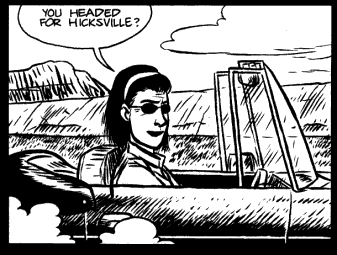
Dylan Horrocks: Hicksville (1998)
There's a lovely sense of recognition when the comic reenacts a classic scene from John O'Shea's pioneering NZ film Runaway (1964) to herald Batts's arrival in town. Things only come into existence the moment they're written about - or filmed, or drawn - in this novel, and such imaginative acts appear to be stored forever in some kind of Akashic tablets of the soul. That, at any rate, is how I read the book's overall message.
Is it strictly a work of speculative fiction, could one say? That's harder for me to answer. Certainly the fact that it's set in an impossible place - a town in a parallel universe (not unlike the one in Moore's Watchmen, where Nixon gets perpetually re-elected, and pirate comics have the place superheroes hold in our reality) - would appear to substantiate the claim.
It's less realist at its roots than either Moby-Dick or Huckleberry Finn: that much is certain. Less, too, than any of its possible rivals for 'Great New Zealand Novel': the bone people ? The Lovelock Version ? The Matriarch (either in the original or in its rewritten version)?
However you classify its genre, for me Hicksville holds all the aces: it's funny, sad, wise, intricate, and incorrigibly from here. It took a long time for the Americans to notice what they had in Melville - not to mention the fact that Mark Twain was something far more than a clown. I hope it doesn't take us quite so long to see the merits of Dylan Horrocks' masterpiece.
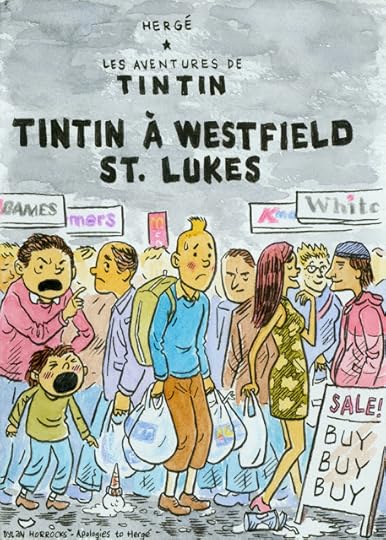
Dylan Horrocks: sketches (2012)
The latest, 2010, edition of the comic includes a wonderfully elegiac introduction. In it Horrocks charts his earliest comics influences - Charles Schulz's Peanuts, Carl Barks' Donald Duck, but above all Hergé's Tintin.
Talk about the landscape (or dreamscape) of my life! I, too, grew up on those comics: Tintin and Asterix, Peanuts and Eagle (my father's particular favourite) - though for us the unquestionable pinnacle was occupied by the seemingly endless permutations of Carl Barks' imagination - even though we didn't even (then) know him by name.
Perhaps, then, I should admit that I am prejudiced. Comics may not be the all-consuming passion for me that they are for Dylan - just one amongst a number of loves - but I understand (and can share) the magic of childhood associations he evokes so well in the Hicksville corpus as a whole.
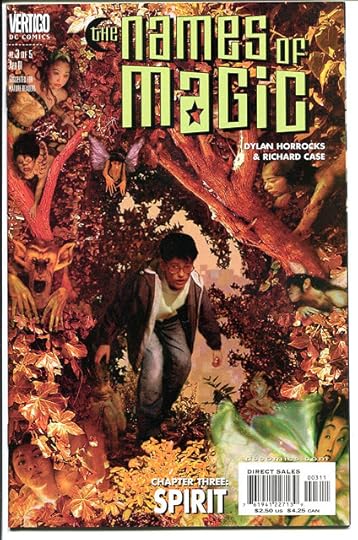
Dylan Horrocks & Richard Case:
Funnily enough, the introduction also touches on his Dick Burger-like decision to get involved in the mainstream comics industry: his work on Timothy Hunter and Batgirl and other titles from Dc's edgier arm Vertigo. As he himself puts it:
The money was great and I worked with some nice people ... but the stories didn't come easily. For the first time in my life I was making comics I couldn't respect. As time went on it grew harder and harder to write or draw my own comics. Soon just looking at a comic - any comic - filled me with dread ... I could no longer see the point of it all ... I should have listened to Sam. [viii]
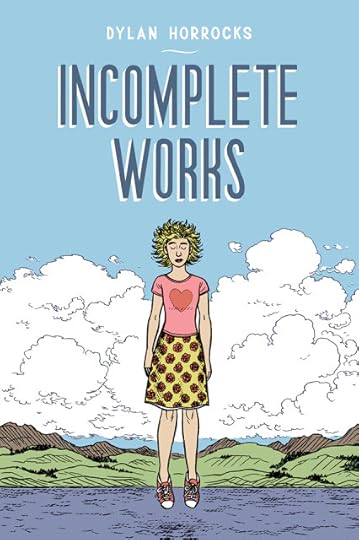
Dylan Horrocks: Incomplete Works (2014)
Twain and Melville, too, suffered through their long nights of the soul. Both of them ran into a creative doldrums after the supreme effort of their great novels. It was good to see Dylan Horrocks back on the bookshops again in 2014 with the double-whammy of Incomplete Works and Sam Zabel and the Magic Pen. It seems he has learned to listen to Sam again, after all.
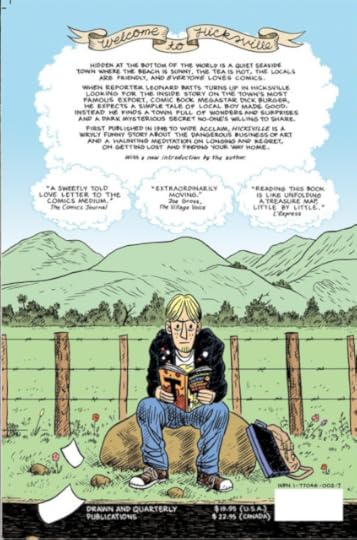
Dylan Horrocks: Hicksville (1998 / 2010)
•

Dylan Horrocks (2019)
Dylan Horrocks
(b. 1966)
Select Bibliography:
Hicksville: A Comic Book. 1998. Montreal: Drawn & Quarterly, 2001.
Hicksville: A Comic Book. 1998. New Edition. Wellington: Victoria University Press, 2010.
The Names of Magic. Illustrated by Richard Case. 2001. New York: Vertigo/DC Comics, 2002.
New Zealand Comics and Graphic Novels. Wellington: Hicksville Press, 2010.
[available for download as a pdf here].
Incomplete Works. Wellington: Victoria University Press, 2014.
Sam Zabel and the Magic Pen. Wellington: Victoria University Press, 2014.
Homepages & Online Information:
Author's Homepage
Wikipedia entry
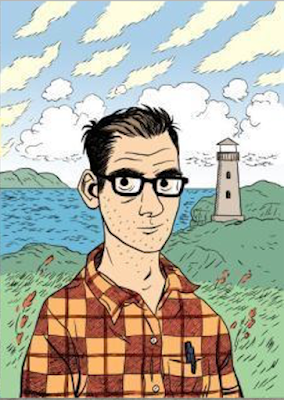
Dylan Horrocks
•
Published on October 06, 2019 13:34
October 4, 2019
Millennials (1): Harry from the Agency (1997)
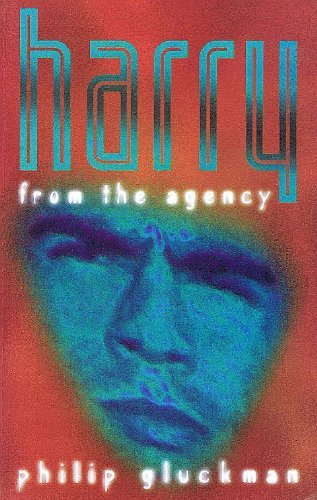
Philip Gluckman: Harry from the Agency (1997)
I don't know why he saved my life. Maybe in those last moments he loved life more than he ever had before. Not just his life... anybody's life... my life. All he'd wanted was the same answers the rest of us want. Where do I come from? Where am I going? How long have I got? All I could do is sit there and watch him die.
- Wikiquotes
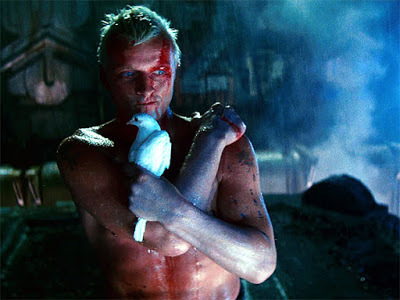
Hampton Fancher & David Peoples: Blade Runner (1982)
Most purists can’t stand the original theatrical release version of Blade Runner, with the intrusive voice-over and the soldered-on happy ending. If that’s the first version of the movie you saw, though (as it was for me), things can seem a bit different.
Some bits of it work pretty well – like the one above, for instance.
I guess that the point of these NZSF essays of mine is somewhat similar – Where did we come from? Where are we going? How long have we got? Does it really matter if New Zealand can claim its own independent SF tradition? Well, I guess that to a dedicated fan, everything matters.
If it gives you a kick - as it does me - to read about a long grey space ship descending over Remuera Rd in Philip Gluckman's Harry from the Agency, then you'll understand what I'm getting at. If not, well:
Breathes there the man, with soul so dead,
Who never to himself hath said,
This is my own, my native land!
- Sir Walter Scott, 'The Lay of the Last Minstrel' (1805)
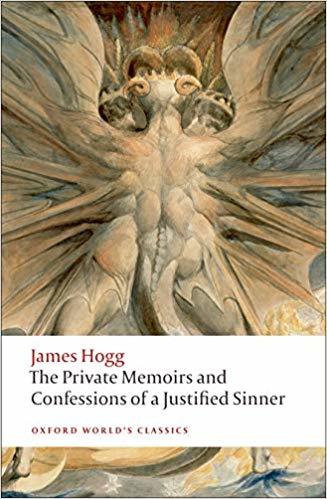
James Hogg: The Private Memoirs and Confessions of a Justified Sinner (1824)
I felt it in Scotland, first, when reading James Hogg's strange, mad Gothic novel The Confessions of a Justified Sinner (1824). The streets his hero trod, the fields on top of Salisbury Crags where he saw his vision of the devil, were familiar to me from my everyday wanderings through Edinburgh.
It's a city that stays, for the most part, the same: the same street layout, the same landmarks. It's definitely strange to be able to retrace someone's steps like that when you hail from a New World city like Auckland, one that rebuilds and reinvents itself every few decades: a bit like Blade Runner's futuristic-yet-retro LA, in fact.
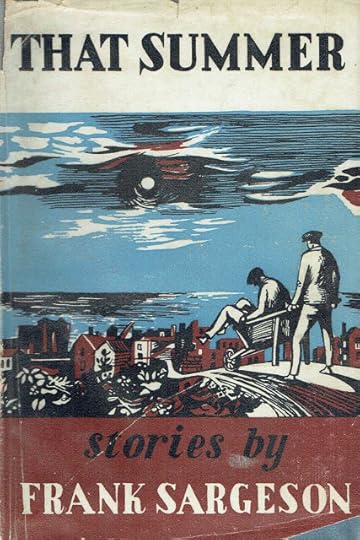
Frank Sargeson: That Summer: Stories. Cover by John Minton (1946)
But then, when I picked up an old edition of Frank Sargeson's That Summer on an Edinburgh bookstall, the fascination with the country of my ancestors, Scotland, shifted slowly to a nostalgia for my own native land - New Zealand.
It's true that That Summer portrays a past so distant, even for me, that it has few connections with the Auckland I remember - but so poignant and beautiful was the story that I've never been able to get out from under its spell ever since. It's my benchmark for a completely successful New Zealand novella: a great and moving story by anyone's standards.
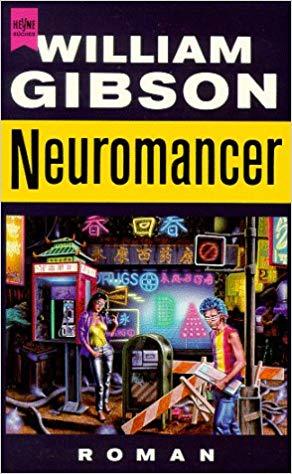
William Gibson: Neuromancer (1984) [German edition]
None of this helps us directly with Harry from the Agency, I suppose, but perhaps it helps to explain why the book has such a powerful charm for me. It's a piece of Kiwi cyberpunk, of course - brewed up from a set of ingredients readily located in the complicated zone between Blade Runner and William Gibson's immensely influential debut novel Neuromancer.
And what is Neuromancer about? It's the first book in the 'Sprawl' trilogy, completed in Count Zero (1986) and Mona Lisa Overdrive (1988). It introduces a world of world-weary Chandleresque antiheroes, roaming through strange city landscapes - half ecological devastation, half virtual reality - and their equally world-weary (but super-cool) girlfriends.
The epitome of all these is the streetwise 'Razorgirl' Molly Millions whom burnt-out hacker Henry Case hooks up with in the novel, and under whose protection he undertakes his dangerous mission into cyberspace (a term Gibson is credited with coining).
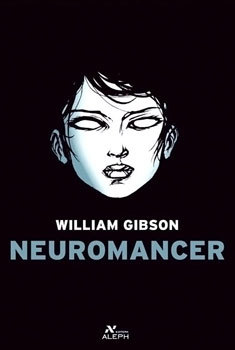
William Gibson: Neuromancer (1984) [Brazilian edition]
[Warning - numerous plot-spoilers ahead]
Sound familiar? For Gibson's protagonist 'Henry Case,' read Gluckman's "Harry Stone' - both drug addicts, both drifters, both selfish almost to the point of insanity. For Gibson's 'Molly Millions,' read, on the romantic side, Gluckman's lithe, long-suffering brunette heroine Toni; on the genetic modification side, the ninja space-assassin Miyuki.
So much is obvious. But the fact that the tropes of cyberpunk are so essentially repetitive as to be easy to replicate - whether in movies such Johnny Mnemonic or The Matrix, or in novels such Lucius Shepard's Life During Wartime (1987) or Bruce Sterling's Islands in the Net (1988) - doesn't mean that there are no meaningful distinctions to be made between these works.
Like the Gothic novel, Cyberpunk used stereotyped motifs to ever more complex ends. The seeds of its destruction lay mainly in the fact that the future it gestured to so beguilingly is now upon us. What its writers assumed would take decades or centuries to accomplish has fallen in on our heads in a matter of a few years.
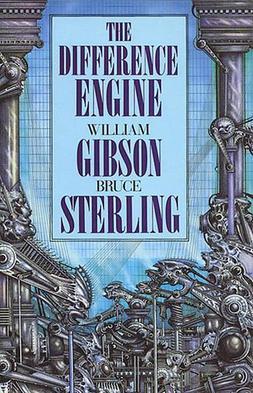
William Gibson & Bruce Sterling: The Difference Engine (1990) [Brazilian edition]
In that respect, William Gibson's other great generic breakthrough, Steampunk - as outlined in his novel The Difference Engine, jointly written with Bruce Sterling - may yet prove to be more enduring.
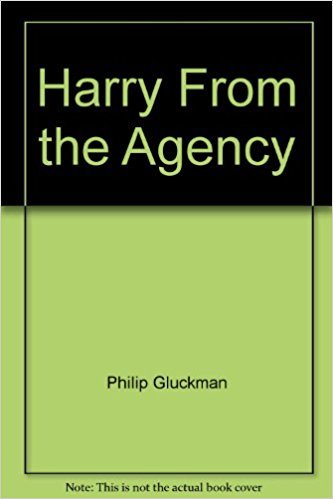
Philip Gluckman: Harry from the Agency (1997)
Third generation of NZ doctors - an old family curse. Keen musician, my novel "Harry from the Agency" is available in all libraries. Absolutely love my job and I have a special interest in treating patients with Hyperhidrosis.According to WebMD, "Hyperhidrosis, or excessive sweating, is a common disorder which produces a lot of unhappiness." I'm not quite sure how it connects with Harry from the Agency, but certainly Harry does a good deal of sweating in the course of the narrative - principally because he's a junkie hooked on heroin, whose horizon is pretty much defined by the prospect of his next fix.
- Dr. Philip Gluckman, 'About.' Albany Family Medical Centre
To add insult to injury (or perhaps to provide Dr. Gluckman with some plot points where he can really use his professional expertise) Harry is also infected with the appalling flesh-eating Delta-8 virus. Rather than offering up hints, though, it might be better simply to quote the book's blurb:
2205 AD. Global warming has accelerated out of control. The middle of the planet is lifeless, drenched in steamy, poisonous rain. Auckland has become a city of islands, and Antarctica is home to most of the world's population. Multinational corporations have deserted Earth to create planetary empires. The Delta-8 virus, a consequence of deep space exploration, is a plague upon the remaining inhabitants.
For Dr Harry Stone, medical section, World Intelligence Agency, time is running out. Not only does he have the virus, the narcotic supply that sustains him is coming to an end. And as his world is failing, Harry is faced with a choice.
Harry from the Agency reveals a convincing future rife with corruption. With its noir atmosphere this book will especially appeal to fans of William Gibson.
Philip Gluckman lives in Auckland. This is his first published novel.
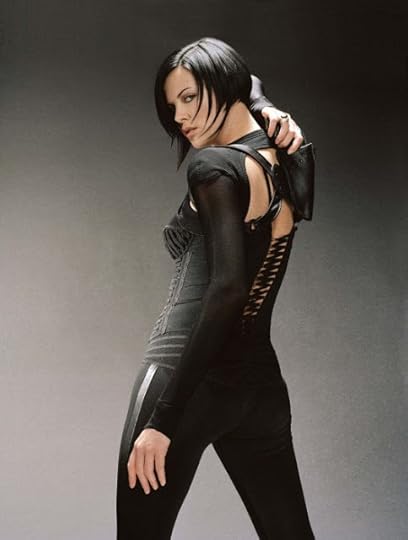
Charlize Theron as Aeon Flux (2010)
Harry from the Agency got a somewhat mixed reception when it first appeared towards the end of the 1990s. I remember hearing a radio review where the two (female) commentators were immensely scornful of Gluckman's heroine Toni. And it's true that, in appearance at least, she sounds a bit like a foretaste of the movie version of Aeon Flux. Slightly more subtle than the animated TV show, but not by much:
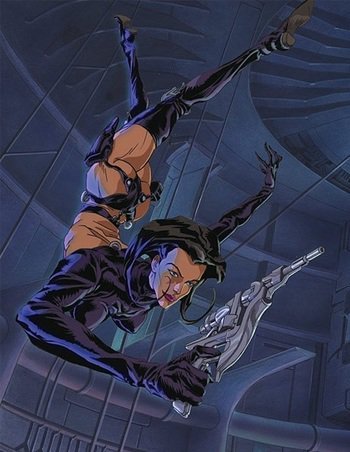
Aeon Flux (MTV: 1991-1995)
Toni sat on the floor. Her sky-blue dressing gown, wrapped tightly around her, concealed perfect skin. Even a casual observer would have been drawn to the fullness of her lips. [16]
She changed into skintight trousers and a jacket over her white singlet, her boots, ran down to her new Triumph, threw on her shades and chopped it into gear. [187]Actually Toni can't even sit at a computer console without looking sexy:
'Something up?' Jackson's baritone voice bellowed from behind the lithe figure, sitting hunched forward over her knees, both feet up on the console, her company jacket off and slung casually over the back of the chair. [135]
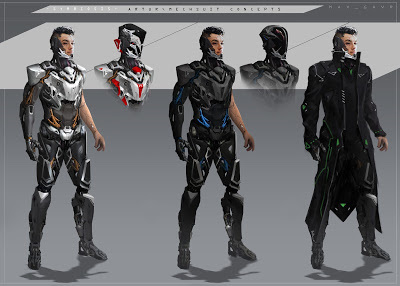
cyberpunk hero
It wasn't really the fact that Toni was so cool (and so hot) that irritated the two radio commentators. It was the fact that she put up with so much from Harry without any obvious return. He had, after all, left her behind to die on a battlefield - though he does have a few weak-kneed excuses for that.
What's more, for all the latent altruism she detected in him - free clinics for the poor, etc. - his main preoccupation throughout is getting more drugs to feed his habit.
'Why,' Robert Graves once asked, 'have such scores of lovely, gifted girls / Married impossible men?'
Simple self-sacrifice may be ruled out,Toni hasn't actually married Harry, but she certainly puts up with more from him that would seem to make any sense. Robert Graves seems no wiser than the rest of us as to why that might be, however, so I guess we just have to accept it as one of the paradoxes of life (or, as in this case, self-indulgent fiction).
And missionary endeavour, nine times out of ten.
Repeat 'impossible men': not merely rustic,
Foul-tempered or depraved
(Dramatic foils chosen to show the world
How well women behave, and always have behaved).
Impossible men: idle, illiterate,
Self-pitying, dirty, sly,
For whose appearance even in City parks
Excuses must be made to casual passers-by.
Has God's supply of tolerable husbands
Fallen, in fact, so low?
Or do I always over-value woman
At the expense of man?
Do I?
It might be so.
- 'A Slice of Wedding Cake'
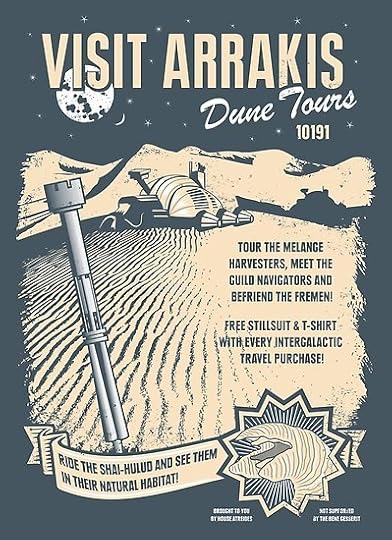
Visit Arrakis: Dune Tours
A good deal of the novel is set on the desert planet Alterrin-3. With its muezzin, and its mad AI cyber-sultan, this planet could certainly be said to have a certain amount in common with the more famous Arrakis (aka 'Dune'), beloved of Frank Herbert fans everywhere.
And, as with Paul Atreides, Harry too goes to ground among a group of indigenous desert people, whose wounds he tends, and who therefore prove willing to assist him in his self-appointed task of broadcasting to the universe the cure to the Delta-8 virus which its creators are trying to suppress.
There's also a galactic empire in the mix: a little like that of the Padishah Emperor, Shaddam IV (or, really, like any other Galactic empire in SF: from Servalan's in Blake's Seven to the one Darth Vader manages in Star Wars). This one is run by Maximilian Oesterburg III - with somewhat less than Teutonic efficiency - for the benefit of his eight-year-old heir, and is, like all corporate entities great or small, devoted to profit and the bottomline over all.
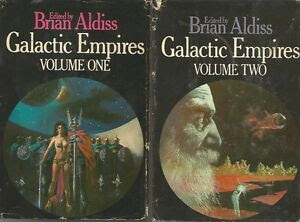
Brian Aldiss, ed. Galactic Empires (1975)
So why should you read this book? It does, after all, consist mainly of a shuffle of the major SF trumps, laid out in a not-unconventional order. Perhaps that's why it's had no (published) sequels, either.
Gluckman writes well. He writes very well. And one can't but feel a strong personal involvement with Harry and Toni which endows them with a certain extra-textual solidity. Harry is a fairly self-indulgent self-portrait, I suppose, but he does have enough defects - alongside a few good qualities - to feel like an actual human being much of the time.
Is the same true of Toni? It's hard to say. But she's certainly no more implausible than Rachael in Blade Runner, Chani in Dune, Molly Millions in Neuromancer, or any of the other razorgirl babes who infest cyberpunk - as well (I suppose) as SF in general.
Strangely enough, it's in its settings that Harry from the Agency really comes alive. Alterrin-3 may not have the solidity of Dune, but it does have an Australian outback feel to it which makes it seem very much like a plausible place.
The islanded Auckland of the future is good, too. Gluckman is wise enough not to indulge in too many Ballardian evocations of the vista, but the hints he drops here and there are enough to give it a solid presence in the mind.

Desert Gardens Hotel
Like most SF futures, Harry from the Agency probably errs on the side of optimism. It's taken quite some time for the ice-caps to melt, after all - and there's only one really incurable plague ravaging the population.
William Gibson, too, has had difficulties with sequels. So powerful was the vision of Neuromancer, that it overshadows everything he's produced under his own name since. Only the collaborative Difference Engine could be said to have matched it.
Perhaps Philip (for a moment I was tempted to call him 'Harry') Gluckman was wise to stop at one novel. It is, after all, extremely accomplished in its own right, and to repeat it would be to risk undermining the effect.
I could easily imagine him writing something else, though, something completely different, possible even out of the speculative fiction mode. Harry from the Agency is auspicious enough as a debut to persuade me that it's a lot more than just another Neuromancer / Dune knockoff transposed to downtown Auckland.

Welcome to 2100: Auckland’s futuristic look!
•

Dr Philip Gluckman
Philip Gluckman
Select Bibliography:
Harry from the Agency. Reed Books. Auckland: Reed Publishing (NZ) Ltd., 1997.
Homepages & Online Information:
Albany Family Medical Centre

•
Published on October 04, 2019 14:17
September 24, 2019
Spirit of '92: Albert Wendt's Black Rainbow
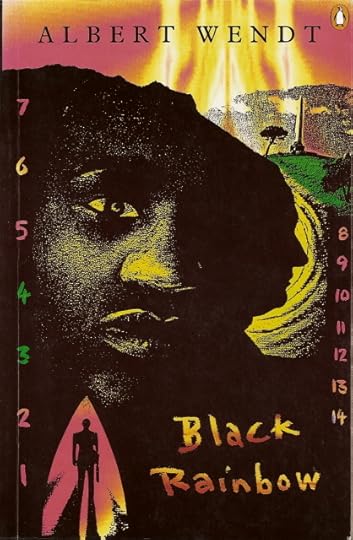
Albert Wendt: Black Rainbow (1992)
'... I don't mind admitting I'm scared ...' I reached out and put an arm around him. 'It's times like these you need ...'
'Minties?' Fantail completed his remark.
'No, it's times like these you need a sense of humour,' Aeto said.
'And our family,' I added. My mother's handprints were still warm on my face.
- Albert Wendt, Black Rainbow (Auckland: Penguin Books, 1992): 235.
Black Rainbow is a difficult book to characterise. It moves like a thriller: first-person narration of reckless escapes and knife fights with a variety of opponents, almost invariably cribbed from other fictions - 'Sister Honey' from Janet Frame's Faces in the Water, 'Big Nurse' from Ken Kesey's One Flew Over the Cuckoo's Nest, Maneco Uriarte from Jorge Luis Borges' Gaucho-esque story '' ...
There's an almost manic lack of consistency about its tone, however: no po-faced hard-boiled intensity can survive exchanges like the one quoted above, where the speakers move from portentous invocations of whakapapa to quotations from ad jingles.
So what's it all about? On the one hand, it's about the erasure of history: the losses (and gains) we achieve by simply writing off the past:
Histories can be erased, I remembered the Tribunal telling me. Erased and replaced with histories that please us. [65]The narrator has been through just such a process of recalling his entire past in order to tape over it at the beginning of the story. He 'graduates' from this process as a free citizen, with a certificate of entitlement to all the state's resources: money, food, accommodation, and the sole remaining mission of tracking down his own family to save them from the strangely motiveless enemies listed above.
'Symbolic much?' to quote a Buffy-ism. Undoubtedly.
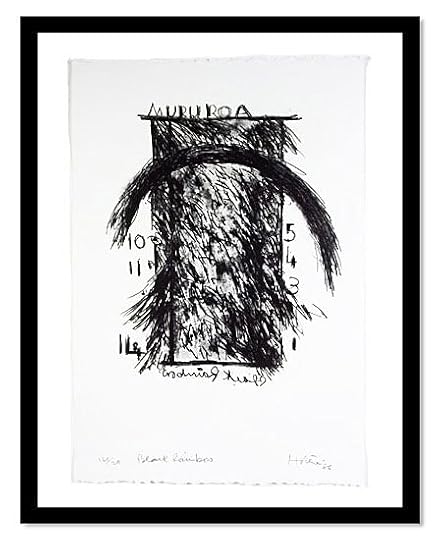
Ralph Hotere: Black Rainbow, Mururoa (1986)
Like the people of Maungakiekie, the Waikato tribes had been turned into grass and meat. History is madness, the Tribunal has prescribed. So I silenced the Hotere clock, pushed down on the accelerator, and sped away from history. [36-37]It isn't entirely clear just which of the various Hotere 'Black Rainbow' etchings the novel is intended to have as its centre, but probably it's the one above. Certainly it has all the characteristics Wendt describes:
I looked at it closely. Recognised the thick black arch to be the rainbow. But the numbers, 1 to 14, on either side of the upsurging cloud? The countdown to what? [10]There's an important scene a few pages later where the narrator's wife shows the picture to the city and the city to the picture, as she circles the Memorial to the Māori race on top of Maungakiekie - or One Tree Hill, as we persist in calling it.

One Tree Hill Memorial (1948):
"This monument was erected in accordance with the will of the late SIR JOHN LOGAN CAMPBELL, Kt, who visualized and desired that a towering obelisk should be erected on this site the summit of Maungakiekie as a permanent record of his admiration for the achievements and character of the great Maori people."
'Once all this and that city was forest,' she said. She gripped the lithograph with both hands.
As she circled the memorial, she held the lithograph out in front of her, like an icon. In it the sky and the full swing of the city were caught. Every shade, shape, light, twist, change and impermanency of them. Reflected there for a time and then lost as she circled.
Was she reinvesting everything with mana? Warding off evil spirits? Or what?
... As the sun rose the lithograph's clock of doom recorded its rising. [18]
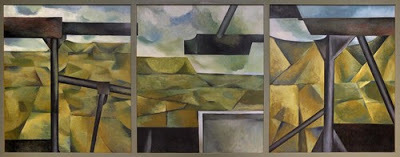
Colin McCahon: On Building Bridges (1952)
As I raced the river through the gap. I thought the hills were straight out of an early Colin McCahon painting. Strange how we see reality through art and the other cultural baggage we carry ...At times the remorseless allusiveness and gagging can become a bit too much. I was working in the English Department at Auckland University in the early 90s, when Prof. Albert Wendt was HOD, and certainly a great many of his colleagues and contemporaries get a skewering: 'venison prepared and cooked to the recipe the Master Chef Thomas Equus served to Queen Elizabeth the day after she bedded Lord Marius Edmond [Murray Edmond]' [186], for instance; or 'the out-of-print historical novels of Morerice Boltshad [Maurice Shadbolt] laced with a bit of Wittie Ishmael [Witi Ihimaear] and Kerrie Me Home [Keri Hulme]' [202]; not to mention 'Ms Michele Letgo [Michele Leggott], owner of Like This? Studs ... Mr Brian Boyed [Brian Boyd], chronicler and owner of Nabocove Stables ...' [207]
I hid the Cheever [which he rented under the name 'Elmore Leonard'] in the bush by the river and crossed the hills on foot ... [65]
But it's important to remember that all this is the consequence of a refusal to stand on your dignity - a deliberate decision not to write in a magisterial monotone, but instead in a punning, Rabelaisian, Carnivalesque mixture of irreconcilable genres.
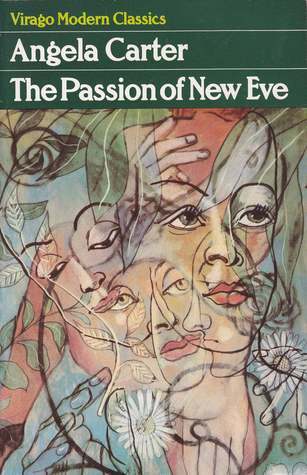
Angela Carter: The Passion of New Eve (1977)
At times it recalls the later works of Angela Carter: The Passion of New Eve, or The Infernal Desire Machines of Doctor Hoffman (1972). There's something of Hermann Hesse's Steppenwolf in there, too: the magic theatre, in particular - and the 'Treatise on the Steppenwolf.'
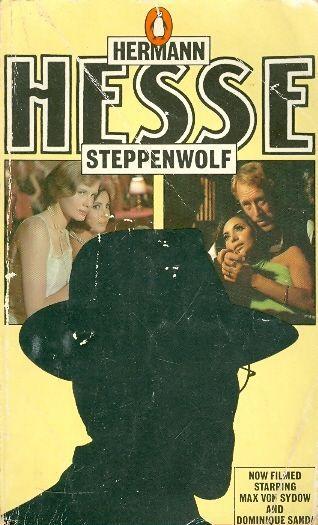
Hermann Hesse: Steppenwolf (1927)
The treeless streets were canyons through which the wind funnelled. In summer the canyons were oppressively hot because the buildings emptied the motors of their airconditioning into them. It was said the streets, shops, malls and apartments were modelled on some of the President's favourite films: Blade Runner, Star Trek and Who Framed Roger Rabbit?, some of my favourite films too. [69]Mentioning Steppenwolf brings in the strong film element in Wendt's novel, too. I think by now that it's apparent that nobody writing about - or even just during - the age of rampant neo-liberalism in New Zealand could avoid making allusions to Blade Runner.
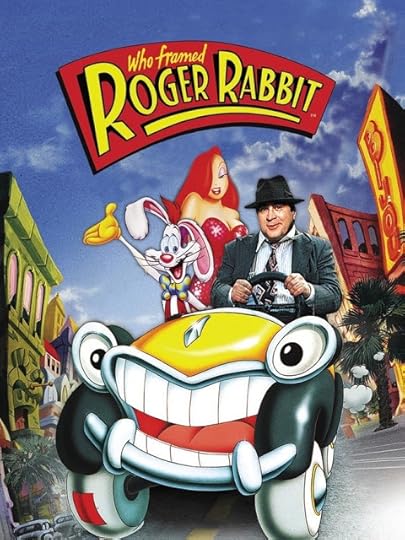
Robert Zemeckis, dir.: Who Framed Roger Rabbit? (1988)
The Toon-town of Who Framed Roger Rabbit? is probably closer to the tone and setting of at least the central sections of Wendt's novel, with its Arabian-Nights-like stories within stories, and characters folding into other characters.
And yet, for all its postmodern, pop-culture exuberance, the central concern of Black Rainbow is never seriously in doubt. Its concern with the erasure of history is, in the final analysis, a refusal to accept the erasure of race. Even in his reincarnation as an unobtrusive bank clerk, the protagonist is never allowed to forget his own difference:
Her hair, the wave and curl of it, that trapped the light and made it look as if it was growing. Then after the dessert of nashis and cream, her remark: 'You're brown too.' And I noticed, for the first time, that she was brown. And so was I. [193]
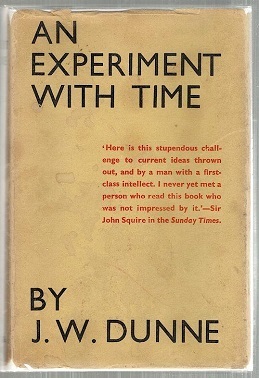
J. W. Dunne: An Experiment with Time (1927)
According to Dunne, our wakeful attention prevents us from seeing beyond the present moment, whilst when dreaming that attention fades and we gain the ability to recall more of our timeline. This allows fragments of our future to appear in pre-cognitive dreams, mixed in with fragments or memories of our past. Other consequences include the phenomenon known as deja vu and the existence of life after death.As a teenage, I took an almost obsessive delight in reading and re-reading J. W. Dunne's book An Experiment with Time. Not so much the technical passages, where he attempts somewhat clumsily to reconcile his ideas of 'serial time' with Einstein's theory of relativity, as the central section, where he records a whole series of dreams as 'proof' that the sleeping mind can somehow step outside linear time, sample as freely from the future as from the past.
- Wikipedia
All that is needed to prove the point, he claims, is a pad and pencil kept beside your bed. The moment you awake, you must write down everything you can remember of your dreams, before they dissipate. Keeping your eyes closed till you've managed to recall those few sensory details that remain of them will have the consequence of bringing back at least a few of the events (or even just the atmosphere) of the narrative you've just been experiencing - not ever, really, in all of its depth and complexity, but in part, at any rate.
After you've done this for some months, the results should be scrutinised and analysed as bits of lived experience jumbled into the dream story - but also little nagging pieces of apparent déjà vu and anticipation of what was (then) still to come: not so much in detail as in their raw outlines.
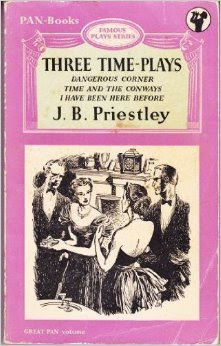
J. B. Priestley: Three Time Plays (1937)
I doubt that any professional psychologists or dream-specialists (Oneirologists?) have ever really taken Dunne very seriously - let alone theoretical physicists. But writers certainly have. J. B. Priestley composed a series of 'time-plays' based directly on his reading of the book, and both J. R. R. Tolkien and C. S. Lewis cited it as an influence on their own understanding (and portrayal) of time.
I don't know if Albert Wendt has ever read the book, or is even familiar with Dunne's theories - but there's something in the jumbled, dreamlike progression of his book that recalls it to me - especially some of Dunne's more canonical dreams, the one about the volcanic eruption on a small island, for instance, or the one about the raging bull which pursues him down the hill.
'History,' says Stephen Dedalus in Ulysses, 'is a nightmare from which I am trying to awake.' The characters in Black Rainbow have been forcibly detached from James Joyces's nets of 'nationality, language, religion,' (as he puts it in A Portrait of the Artist as a Young Man), but in the process they have lost all sense of an individual identity.
Wendt's novel is a satire, finally - it offers no solutions to the problems it poses, but clowns valiantly on the edge of the abyss. Its message, however, is clear. We must beware of awakening from one nightmare - history - for fear of being plunged, willy-nilly, into another.
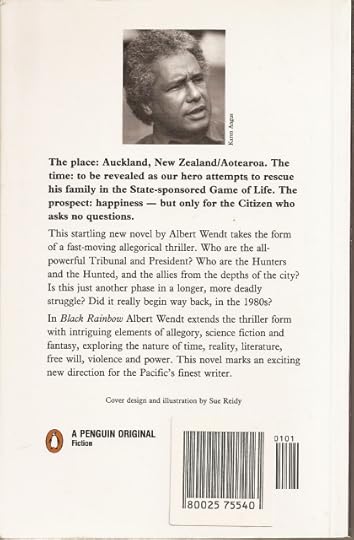
•
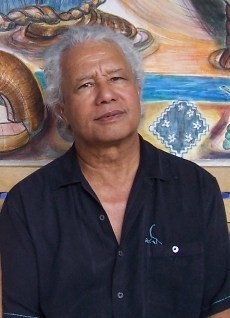
Albert Wendt
Albert Wendt
(1939- )
Select Bibliography:
Fiction:
Sons for the Return Home (1973)
Flying Fox in a Freedom Tree: And Other Stories (1974)
Pouliuli. Pacific Paperbacks. Auckland: Longman Paul Limited, 1977.
Leaves of the Banyan Tree. Auckland: Longman Paul Limited, 1979.
The Birth and Death of the Miracle Man (1986)
Ola (1991)
Black Rainbow. Auckland: Penguin Books, 1992.
The Best of Albert Wendt's Short Stories. A Vintage Book. Auckland: Random House New Zealand, 1999.
The Mango's Kiss: a Novel (2003)
The Adventures of Vela (2009)
Ancestry (2012)
Breaking Connections (2015)
Poetry:
Inside Us the Dead. Poems 1961 to 1974 (1976)
Shaman of Visions (1984)
Photographs. Auckland: Auckland University Press, 1995.
The Book of the Black Star. Auckland: Auckland University Press, 2002.
From Mānoa to a Ponsonby Garden. Auckland: Auckland University Press, 2012.
Memoir:
Out of the Vaipe, The Deadwater: A Writer's Early Life (2015)
Homepages & Online Information:
Read NZ Te Pou Muramura entry
Wikipedia entry
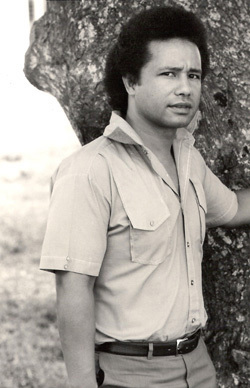
Albert Wendt
•
Published on September 24, 2019 16:15
September 15, 2019
John Cranna's Arena (1992)

John Cranna: Arena (1992)
The worst effects of malnutrition, he continued, were on the mind. 'I've known starving men who listened to their thoughts and believed they had invented a strange new language.' He tapped the point of the toothpick on his front teeth. 'They died convinced they were geniuses.'
- John Cranna, Arena (Auckland: Minerva New Zealand, 1992): 104.
Somewhere in the space between J. G. Ballard's The Drowned World (1962) and J. M. Coetzee's Booker-Prize-winning Life & Times of Michael K (1983) lies the zone of John Cranna's first (and, to date, only) novel, Arena.
Like them, it's dystopian; like them, disturbingly violent. Arena also shares with both books a kind of deadpan flatness of affect - though all three authors show a taste for occasional flights of poetic fancy.
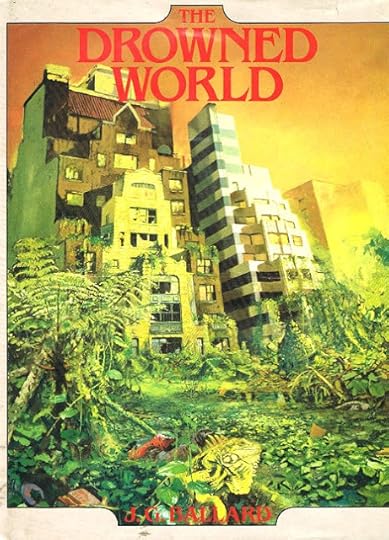
J. G. Ballard: The Drowned World (1962)
J. G. Ballard's first novel is set in a drowned London of the future. The characters have the usual Ballardian preoccupations with inner space: with the working out of their personal obsessions rather than any more practical, world-altering activities.
Even the bizarre ceremony which serves as the culmination of whatever narrative arc the novel has proves strangely anticlimactic: Dr. Kerans survives his ordeal, and wanders off at the end of the novel in search of "the forgotten paradises of the reborn Sun."
It's hard, however, to forget the lush evocativeness of the picture Ballard paints - of a world ending not with a bang but a whimper. Who would have thought at the time that his fantasies would seem so timely and relevant so soon?
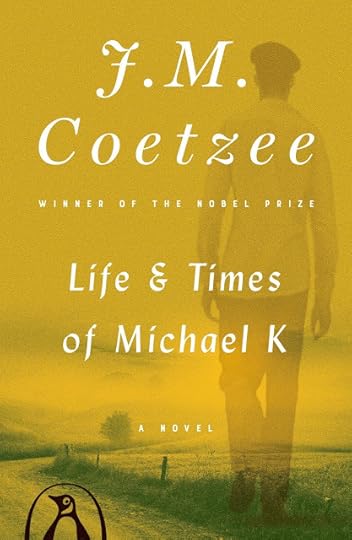
J. M. Coetzee: Life & Times of Michael K (1985)
Coetzee's Life & Times of Michael K is more poignant. It is, in fact, a very difficult book to characterise even to those familiar with Coetzee's other novels. The solitary, arduous odyssey of the deformed, hare-lipped Michael K through the war-ravaged landscapes of a frighteningly real - albeit on an alternate historical time-track - South Africa, is simultaneously grotesque and inspiring.
Michael K's status as an unperson ("CM [coloured male] - 40 [his age] - NFA [no fixed address] - Unemployed") is established very clearly in context, and yet it's the actual nature of his quest that matters. The civil war ravaging the landscape is above (or below) his attention. His only approach to success in the book lies in the garden he makes in the provinces before returning to Cape Town.
•
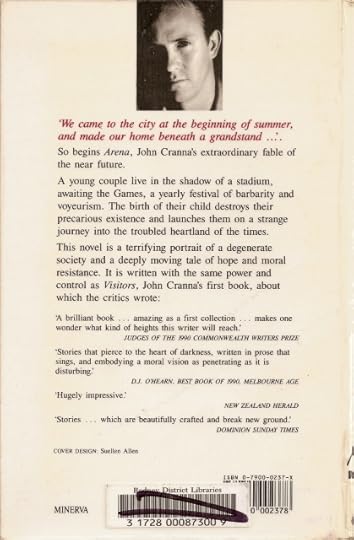
Brain-damaged by the nineties, openly neglected by authorities, their school buildings falling unhindered around their ears, the kids had all the helpless savagery of young animals left out in the cold too soon.
- Rosie Scott, Feral City (Port Melbourne, Victoria: William Heinemann Australia, 1992): 19.
In terms of a strictly New Zealand speculative fiction, the juxtaposition works somewhat differently. Somewhere between Rosie Scott's Feral City and Albert Wendt's Black Rainbow lies Arena (all three were published in the same year: 1992).
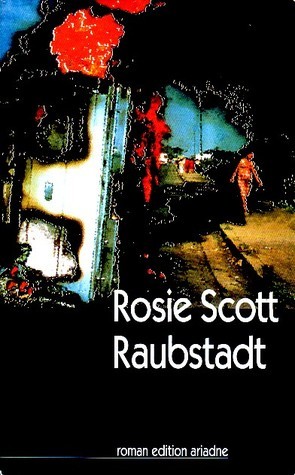
Rosie Scott: Raubstadt [Feral City] (1992)
Rosie Scott's vision of a near-future inner-city Auckland devastated by neo-liberal monetarism may seem a long way from John Cranna's magic-realist city, where "a yellow haze obscured the horizon from the slums of the south to the Guest suburbs in the north" [27], but they do have certain tropes and assumptions in common.
The gleaming teethed "guests" who appear to be in control of the body politic in Cranna's fable are not a long way from the equally sinister authorities in Scott's - or, for that matter, the elaborate Orwellian apparatus of Albert Wendt's.
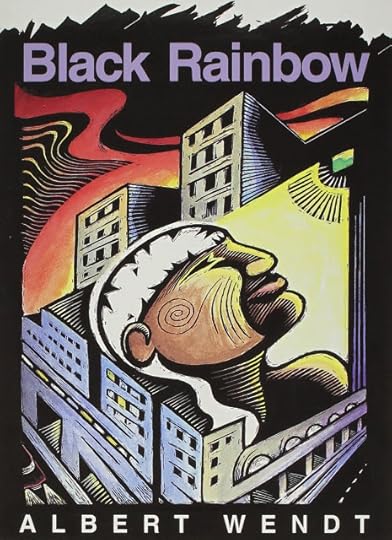
Albert Wendt: Black Rainbow (1992)
"One day the history of our nation would become clearer to her. When the time was right I would try to explain a few things." [141]
Mary Paul's recent essay "Always Something There to Remind Me: On Growing Up Amid Neoliberal Reforms" Pantograph Punch: 19/8/19) might act as a timely reminder of the spirit of that particular age, for those fortunate enough not to have lived through it.
Hers is, by its nature, a very partial view: Auckland-centric (like the three novels mentioned above), and surprisingly male-dominated. 'Didn't you want to interview any women?' was one of the comments listed under the piece when it first appeared.
That isn't entirely fair, mind you. The last interview (of five) in the article is with the couple Richard Misilei and Mate Colvin, who both work as librarians in Ōtara. All the others, though: writer and performer Dominic Hoey (aka 'Tourettes'); 'Stephen' (not his real name); performance artist Mark Harvey; and AUT Communications Senor Lecturer Thomas Owen, are indeed men, and - it would have to be admitted - offer distinctively male perspectives on the period.
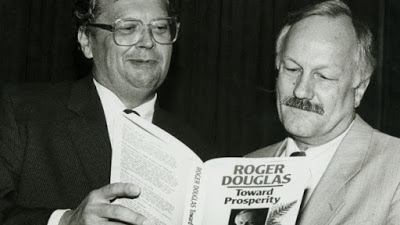
Mary Paul: Always Something There to Remind Me (2019)
Mary begins with a quote from Economist Tim Hazeldine, who describes the fallout from the 'reforms' of this era as “terrible”:
I cannot find any developed economy in modern times that has inflicted so much harm on itself. 104 major reforms pummel[ed] the body-economic. One manufacturing job in three was lost, and with those jobs basically went the blue-collar core that is crucial to the chances of less skilled workers being able to support their families in decency.She does, however, preface this in more personal terms:
In the early 1990s I often woke at night worrying about how our children would manage in a newly competitive world. If they couldn’t strive to be the best, or at least buy into the idea of life as raw competition, how would they manage? It was not so much a feeling of pressure as one of loss. Would there be a place for them to flourish – one organised around human values and community, and not only around competition and consumerism?Is that what John Cranna's Arena is about, also? That sense of fear over eroding values? Certainly his (unnamed) protagonist lacks any conventional moral compass. He cuts off a man's ear-lobe and chains him to a tree in the garden as a simple act of discipline, and his somewhat tepid feelings of solidarity with the Aboriginal escapee from the livestock collected for the upcoming Arena Festival do not extend to any attempt to liberate him when recaptured for sacrifice.
The country had changed in 1984, when a newly elected Labour Government implemented free-market reforms with extreme rapidity, reforms that were extended in the early 1990s by the subsequent National Government. What was done was oddly extreme for a well-developed Western democracy and an elected Labour government, or any government. However giving precedence to business did fit with the crude empirical generalisations that were current at the time about society being founded on self-interest.
His strongest identification turns out to be with the children of the next generation, but even this seems as much sensual as ideological:
The girl child's green, wide-set eyes met mine. Poised there was the question that had been put to me twice, the invitaion that had pursued me to the swamps and had haunted my dreams. And as the wind blew sand in flurries across the arena, and brought to that place the scent of end-of-summer orchards, I reached out to the small white hand of this dancer, my daughter, and told her, Yes. [174]Bear in mind that this is the end of the same summer in which this particular child was born. A brief riffle back in the pages reveals the question - or, rather, statement - twice put to him: "We want you to be the narrator" [160].
But what exactly is it that he's meant to be narrating?

Migrant Workers' Children (2011)
... in a sense, everything that happened that summer was predictable, and with time it seemed to me that when the sequence of events happened as it did, it did so with an inevitability that left me certain that somehow I had known what was going to happen all along. [50]
There's a certain clunkiness to that sentence, and - it has to be admitted - to John Cranna's book as a whole. It's as if he's so determined to make each action deeply significant, that he neglects to explain it - even to himself. It reads like a sleepwalker's book.
Ballard's novels sounds now like an example of cli-fi written long before that term was born or thought of. Coetzee's, too, has a clear political dimension alongside the fabular narration. Scott and Wendt, too, have their targets (and genres) clearly in their sights.
What, then, of John Cranna? More than 25 years on, any deficiencies in clarity of intention seem - to me, at any rate - outweighed by the obscure feeling of hurt underlying his story. His protagonist (like the author?) has returned to home ground round to tell us his story once more in the faint hope that this time it may end up making some tenuous kind of sense.
His hopes - as always - are disappointed, but at least he's managed, this time, to gather around him a small knot of children who may offer some kind of hope, however fragile:
O body swayed to music, O brightening glance,Or, to put it more directly, how can there be narrative closure where we ourselves deserve none?
How can we know the dancer from the dance?
- W. B. Yeats, "Among School Children"
•

John Cranna
John Cranna
(b.1954)
Select Bibliography:
Visitors. Pacific Writers Series. Auckland: Heinemann Reed, 1989.
Arena. Auckland: Minerva, 1992.
Homepages & Online Information:
The Creative Hub
Wikipedia entry
•
Published on September 15, 2019 15:49
September 7, 2019
Rosie Scott and the Mother of All Budgets (1992)
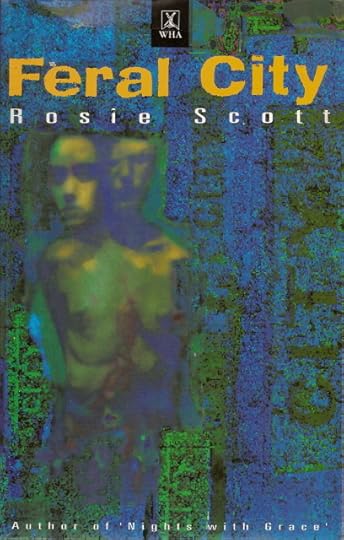
Rosie Scott: Feral City (1992)
'... It's not easy setting up in Apocalypse Now city. But at least I can choose the books I love.'
- Rosie Scott, Feral City (Melbourne: Heinemann, 1992): 126.
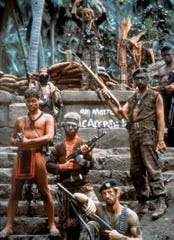
Francis Ford Coppola, dir.: Apocalypse Now (1979)
I came back to New Zealand in 1990, after four years away in the UK. It was as if I’d left one country and returned to another.
True, my father’s letters had alerted me to some of what was going on during Roger Douglas’s reign of terror over Treasury, and I had made a short trip home in ’88, in time to see the aftermath of the 1987 stock market ‘correction’.
Coming back to live was something quite different, though.
The New Zealand I remembered was a place where people had the luxury of time and leisure to occupy themselves with worthy causes: Apartheid in South Africa, for instance, or the pernicious effects of raising the level of Lake Manapouri.
The New Zealand I came back to was far more brutal and opportunist. The comforting, vaguely socialist, vaguely lefty convictions which had seemed to be the common property of most people I knew had been replaced with Monetarist zeal. Get rich quick or die trying – push the weak to the wall or they’ll hold you back.
I remember seeing, on the news, a funeral eulogy delivered over the coffin of a rich entrepreneur of that era by his grieving son: 'My father taught me an important lesson,' he said. We all awaited some tender homily. 'He told me that if your opponent is down in the gutter, go over and kick him in the throat, then stamp on his face till he dies.'
The audience - in the Christchurch town hall, I think it was - erupted in baying laughter, their jackal faces convulsed with glee. That was the spirit of the age, I'm sorry to say. In some circles it still is.
•
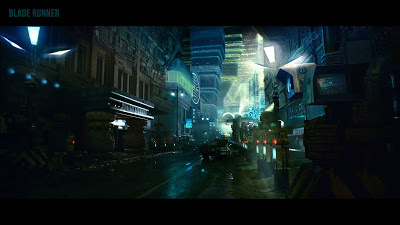
Ridley Scott, dir.: Blade Runner (1982)
'The seasons have all changed,' Violet said with foreboding. 'The rain's changed. There's no freshness to it any more. It rains and you know that it's pathology. It comes from some global sickness.
'It's like Blade Runner,' I said to myself.
'Blade Runner?'
'It's an old movie. Images of the future, unwholesome rain falling continuously on desolate cities. No untouched nature left to replenish ourselves spiritually with.' [79]
I remember once, shortly after my return, being asked what I did for a living by a woman who ran a bookshop. I told her that I was looking for work at present, having just come back after a long stay away.
‘I have a job for you: cleaning the shop,’ she said.
‘Oh, I don’t think I’d be very good at that,’ I replied, a little surprised at the vehemence with which she accosted me.
‘Too good for it, are you?’
‘No, it’s not that. It’s just that the country paid a good deal of money for me to go abroad and study, and it seems a bit pointless to come back and not use any of the things I learned.’
‘So you’d rather go on the benefit and live off the rest of us?’
I think I managed to extricate myself at that stage, resolving never to enter that shop again.
It’s not that I couldn’t see her point. Of course I looked like a shiftless wastrel – and what good was all that education when all it really consisted of was reading a bunch of books and making a few generalisations about them in the form of a Doctoral thesis?
Outside a very narrow, specialised sphere, I clearly wasn't at all viable in the new New Zealand. It didn't help that (as I subsequently learned) the bookshop lady's husband was a National Party politician.
•
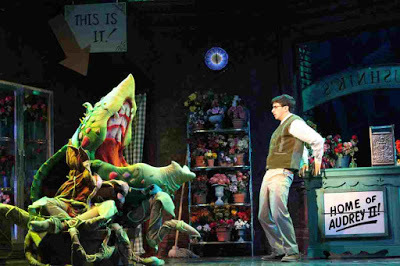
Frank Oz, dir.: Little Shop of Horrors (1986)
'We used to call it the Little Shop of Horrors,' I said, thinking out loud. 'Quite witty for white trash.' ...
'You keep remembering everything,' Violet said. 'I've been here so long everything's kind of overlapped. The old memories are diluted by the last few years, so everything's just become one long uneasy present.' [26-27]
I suppose that’s why I retain so much fondness for Rosie Scott’s visionary novel Feral City. When I finally got around to reading it, some years later, it seemed to me to capture almost perfectly the feeling of those times.
When the National Party duly returned to power in the 1990 election – after the unedifying débâcle of David Lange’s attempt to impose ‘a cup of tea and a sit-down’ on his madder, more free market colleagues – they sure came in with a hiss and a roar.
Ruth Richardson strode like a colossus over the ruins of that gentler, less stratified New Zealand. Her 1991 ‘Mother of all Budgets’ cut state spending on an unprecedented scale, adding Ruthanasia to the devastation wrought by Rogernomics.
Was it all worth it in the long run? It depends on who you talk to, I suppose.
Certainly some people did become significantly richer as a result of it. Countries such as Australia which avoided such policies at that time don’t seem to have suffered unduly as a result, however.
One would have to know far more about economics than I do to venture a valid opinion – all I know is that what I saw bore more than a passing resemblance to the Britain I’d just left, stricken by over a decade of Thatcherite tyranny.
•
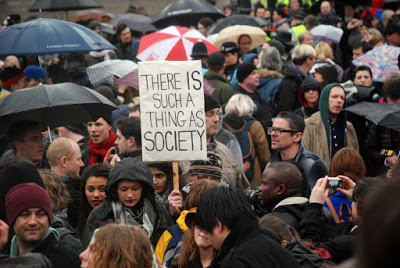
Thatcher's death 'celebrated' in London (2013)
Feral City is the city of our future, its centre a wasteland people by addicts, violent gangs and the homeless. In a gesture of defiant optimism, two sisters - one a warrior, the other a survivor - open a bookshop in the heart of this decaying city. Their bizarre and moving story mirrors the fragile balance between defeat and courage.
With the passionate imagination we now expect from her, Rosie Scott presents a future shock which is alive with imminent danger.
Does Feral City really qualify as Speculative Fiction? It’s dystopian, yes – set in a near future which is mostly an exacerbated version of the author’s present. But then that is, then and now, the nature of the beast. Certainly the blurb above characterises it as some kind of Jeremiad.
After all, the same could be said of C. K. Stead’s Smith’s Dream or even Craig Harrison’s The Quiet Earth. Both novels extrapolate from present trends to prophesy and warn. And, while that may not be the whole duty of SF - perish the thought - it’s certainly one important part of its function as a genre.
Mostly, I think, Scott’s novel survives in the mind because of its expert evocation of atmosphere – that, and her fascination with human eccentricity. That memorable image of the old book exchange linked internally by a crudely bashed-in tunnel to the fish-shop next door, simply in order to find more space for Faith's utopian vision of the perfect bookshop, is certainly one that stayed with me long after I'd forgotten most of the rest of the plot.
•
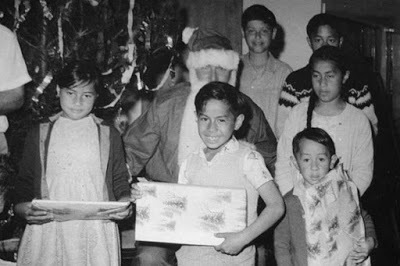
Ponsonby's Pacific past (Auckland Heritage Festival, 2018)
'... There's got to be a Pacific feel to it, as well. You know that Polynesian bookshop that used to be in K-Road? In the arcade? Is it still there? You used to see all those working people come in with overalls and work-boots on. They were at ease. They were recognising something valuable that belonged to them.'
'You talk about them as if they're some sort of shy forest animal coming in to drink at the bambi pool.' [10]
Of course it's of its time: more than a quarter of a century ago now. There's a certain naïveté to its assumption that we've seen the worst already, and that it consists of social neglect and poverty. That's where the choice of a novel rather than some more one-sided diatribe serves Scott well, though.
Every time Faith says something particularly naff, Violet can shoot her down with more street-based arguments. The two function very well together as the interlocutors in a Platonic dialogue about, on the one hand, offering a possible vision of a life well lived (Faith's green, welcoming bookshop) or choosing direct, practical action (Violet's warehouse of donated goods, her soup runs in the broken-down old van).
More to the point, as they grow as characters and human beings, it allows Scott to say some important things about the deep bond between sisters, the details only they can know about each other: the wounds only they can inflict.
Rosie Scott writes like an angel, of course. The clarity and analytic power of her prose comes from her father, historian and social activist Dick Scott, I guess - but the poetic, incantatory effect of her sentences is all her own:
It seemed more and more amazing that I hadn't really noticed the state of the city in the first flush of homecoming. ... But gradually the city impinged more and more on my consciousness, like a black shield held against the sun. They were still my childhood streets with their shops and garages and pubs ... but as the days went by, I saw more and more clearly that something had changed, a slant of light, a feeling in the air.
At night the homeless people lit huge bonfires in rusty petrol drums and I could see the shadow of the flames flickering on the storeroom ceiling as I lay on a mattress on the floor trying to sleep. I kept hearing their harsh voices, sudden jolting snarls of rage, the clink of bottles, a snatch of ragged singing. They were like voices from the dead, remote, an undercurrent of menace, a strange and ghostly community. In the daytime there were no signs, just newspaper blowing in the wind and young guys walking past like cowboys, stiff-legged, eyes ahead, past the seedy shops. ...
'They're the ragged army,' Violet told me. 'There're thousands of them now. Families camped out in the streets, in old cars, under the freeway flyovers, in shopping malls, in cardboard boxes on the side of the road. There's nowhere for them to go.' [47-48]
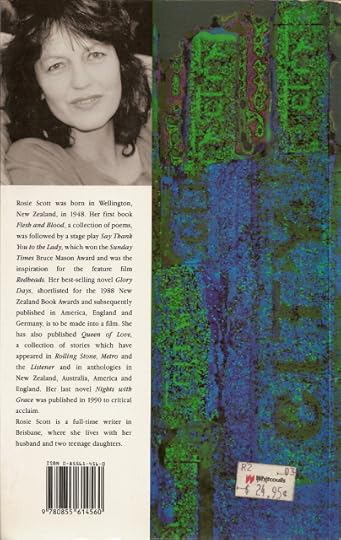
•

Rosie Scott
Rosie Scott
(1948-2017)
Select Bibliography:
Books:
Flesh and Blood: Poems (1984)
Say Thank You to the Lady: A Play (1985)
Glory Days: A Novel. Auckland: Penguin, 1988.
Queen of Love: Short Stories (1989)
Nights with Grace. Pacific Writers Series. Auckland: Heinemann Reed, 1990.
Feral City. Port Melbourne, Victoria: William Heinemann Australia, 1992.
Lives on Fire. Auckland: Sceptre NZ, 1993.
Movie Dreams (1995)
The Red Heart. A Vintage Book. Auckland: Random House New Zealand, 1999.
Faith Singer (2003)
Edited:
[with Thomas Keneally] Another Country (2014)
[with Thomas Keneally] A Country Too Far (2004)
[with Anita Heiss] The Intervention (2015)
Homepages & Online Information:
NZ Book Council
Wikipedia entry

Eric Heath: Croaking Cassandra (1991)
Published on September 07, 2019 14:58
Rosie Scott and the Mother of All Budgets

Rosie Scott: Feral City (1992)
'... It's not easy setting up in Apocalypse Now city. But at least I can choose the books I love.'
- Rosie Scott, Feral City (Melbourne: Heinemann, 1992): 126.

Francis Ford Coppola, dir.: Apocalypse Now (1979)
I came back to New Zealand in 1990, after four years away in the UK. It was as if I’d left one country and returned to another.
True, my father’s letters had alerted me to some of what was going on during Roger Douglas’s reign of terror over Treasury, and I had made a short trip home in ’88, in time to see the aftermath of the 1987 stock market ‘correction’.
Coming back to live was something quite different, though.
The New Zealand I remembered was a place where people had the luxury of time and leisure to occupy themselves with worthy causes: Apartheid in South Africa, for instance, or the pernicious effects of raising the level of Lake Manapouri.
The New Zealand I came back to was far more brutal and opportunist. The comforting, vaguely socialist, vaguely lefty convictions which had seemed to be the common property of most people I knew had been replaced with Monetarist zeal. Get rich quick or die trying – push the weak to the wall or they’ll hold you back.
I remember seeing, on the news, a funeral eulogy delivered over the coffin of a rich entrepreneur of that era by his grieving son: 'My father taught me an important lesson,' he said. We all awaited some tender homily. 'He told me that if your opponent is down in the gutter, go over and kick him in the throat, then stamp on his face till he dies.'
The audience - in the Christchurch town hall, I think it was - erupted in baying laughter, their jackal faces convulsed with glee. That was the spirit of the age, I'm sorry to say. In some circles it still is.
•

Ridley Scott, dir.: Blade Runner (1982)
'The seasons have all changed,' Violet said with foreboding. 'The rain's changed. There's no freshness to it any more. It rains and you know that it's pathology. It comes from some global sickness.
'It's like Blade Runner,' I said to myself.
'Blade Runner?'
'It's an old movie. Images of the future, unwholesome rain falling continuously on desolate cities. No untouched nature left to replenish ourselves spiritually with.' [79]
I remember once, shortly after my return, being asked what I did for a living by a woman who ran a bookshop. I told her that I was looking for work at present, having just come back after a long stay away.
‘I have a job for you: cleaning the shop,’ she said.
‘Oh, I don’t think I’d be very good at that,’ I replied, a little surprised at the vehemence with which she accosted me.
‘Too good for it, are you?’
‘No, it’s not that. It’s just that the country paid a good deal of money for me to go abroad and study, and it seems a bit pointless to come back and not use any of the things I learned.’
‘So you’d rather go on the benefit and live off the rest of us?’
I think I managed to extricate myself at that stage, resolving never to enter that shop again.
It’s not that I couldn’t see her point. Of course I looked like a shiftless wastrel – and what good was all that education when all it really consisted of was reading a bunch of books and making a few generalisations about them in the form of a Doctoral thesis?
Outside a very narrow, specialised sphere, I clearly wasn't at all viable in the new New Zealand. It didn't help that (as I subsequently learned) the bookshop lady's husband was a National Party politician.
•

Frank Oz, dir.: Little Shop of Horrors (1986)
'We used to call it the Little Shop of Horrors,' I said, thinking out loud. 'Quite witty for white trash.' ...
'You keep remembering everything,' Violet said. 'I've been here so long everything's kind of overlapped. The old memories are diluted by the last few years, so everything's just become one long uneasy present.' [26-27]
I suppose that’s why I retain so much fondness for Rosie Scott’s visionary novel Feral City. When I finally got around to reading it, some years later, it seemed to me to capture almost perfectly the feeling of those times.
When the National Party duly returned to power in the 1990 election – after the unedifying débâcle of David Lange’s attempt to impose ‘a cup of tea and a sit-down’ on his madder, more free market colleagues – they sure came in with a hiss and a roar.
Ruth Richardson strode like a colossus over the ruins of that gentler, less stratified New Zealand. Her 1991 ‘Mother of all Budgets’ cut state spending on an unprecedented scale, adding Ruthanasia to the devastation wrought by Rogernomics.
Was it all worth it in the long run? It depends on who you talk to, I suppose.
Certainly some people did become significantly richer as a result of it. Countries such as Australia which avoided such policies at that time don’t seem to have suffered unduly as a result, however.
One would have to know far more about economics than I do to venture a valid opinion – all I know is that what I saw bore more than a passing resemblance to the Britain I’d just left, stricken by over a decade of Thatcherite tyranny.
•

Thatcher's death 'celebrated' in London (2013)
Feral City is the city of our future, its centre a wasteland people by addicts, violent gangs and the homeless. In a gesture of defiant optimism, two sisters - one a warrior, the other a survivor - open a bookshop in the heart of this decaying city. Their bizarre and moving story mirrors the fragile balance between defeat and courage.
With the passionate imagination we now expect from her, Rosie Scott presents a future shock which is alive with imminent danger.
Does Feral City really qualify as Speculative Fiction? It’s dystopian, yes – set in a near future which is mostly an exacerbated version of the author’s present. But then that is, then and now, the nature of the beast. Certainly the blurb above characterises it as some kind of Jeremiad.
After all, the same could be said of C. K. Stead’s Smith’s Dream or even Craig Harrison’s The Quiet Earth. Both novels extrapolate from present trends to prophesy and warn. And, while that may not be the whole duty of SF - perish the thought - it’s certainly one important part of its function as a genre.
Mostly, I think, Scott’s novel survives in the mind because of its expert evocation of atmosphere – that, and her fascination with human eccentricity. That memorable image of the old book exchange linked internally by a crudely bashed-in tunnel to the fish-shop next door, simply in order to find more space for Faith's utopian vision of the perfect bookshop, is certainly one that stayed with me long after I'd forgotten most of the rest of the plot.
•

Ponsonby's Pacific past (Auckland Heritage Festival, 2018)
'... There's got to be a Pacific feel to it, as well. You know that Polynesian bookshop that used to be in K-Road? In the arcade? Is it still there? You used to see all those working people come in with overalls and work-boots on. They were at ease. They were recognising something valuable that belonged to them.'
'You talk about them as if they're some sort of shy forest animal coming in to drink at the bambi pool.' [10]
Of course it's of its time: more than a quarter of a century ago now. There's a certain naïveté to its assumption that we've seen the worst already, and that it consists of social neglect and poverty. That's where the choice of a novel rather than some more one-sided diatribe serves Scott well, though.
Every time Faith says something particularly naff, Violet can shoot her down with more street-based arguments. The two function very well together as the interlocutors in a Platonic dialogue about, on the one hand, offering a possible vision of a life well lived (Faith's green, welcoming bookshop) or choosing direct, practical action (Violet's warehouse of donated goods, her soup runs in the broken-down old van).
More to the point, as they grow as characters and human beings, it allows Scott to say some important things about the deep bond between sisters, the details only they can know about each other: the wounds only they can inflict.
Rosie Scott writes like an angel, of course. The clarity and analytic power of her prose comes from her father, historian and social activist Dick Scott, I guess - but the poetic, incantatory effect of her sentences is all her own:
It seemed more and more amazing that I hadn't really noticed the state of the city in the first flush of homecoming. ... But gradually the city impinged more and more on my consciousness, like a black shield held against the sun. They were still my childhood streets with their shops and garages and pubs ... but as the days went by, I saw more and more clearly that something had changed, a slant of light, a feeling in the air.
At night the homeless people lit huge bonfires in rusty petrol drums and I could see the shadow of the flames flickering on the storeroom ceiling as I lay on a mattress on the floor trying to sleep. I kept hearing their harsh voices, sudden jolting snarls of rage, the clink of bottles, a snatch of ragged singing. They were like voices from the dead, remote, an undercurrent of menace, a strange and ghostly community. In the daytime there were no signs, just newspaper blowing in the wind and young guys walking past like cowboys, stiff-legged, eyes ahead, past the seedy shops. ...
'They're the ragged army,' Violet told me. 'There're thousands of them now. Families camped out in the streets, in old cars, under the freeway flyovers, in shopping malls, in cardboard boxes on the side of the road. There's nowhere for them to go.' [47-48]

•

Rosie Scott
Rosie Scott
(1948-2017)
Select Bibliography:
Books:
Flesh and Blood: Poems (1984)
Say Thank You to the Lady: A Play (1985)
Glory Days: A Novel. Auckland: Penguin, 1988.
Queen of Love: Short Stories (1989)
Nights with Grace. Pacific Writers Series. Auckland: Heinemann Reed, 1990.
Feral City. Port Melbourne, Victoria: William Heinemann Australia, 1992.
Lives on Fire. Auckland: Sceptre NZ, 1993.
Movie Dreams (1995)
The Red Heart. A Vintage Book. Auckland: Random House New Zealand, 1999.
Faith Singer (2003)
Edited:
[with Thomas Keneally] Another Country (2014)
[with Thomas Keneally] A Country Too Far (2004)
[with Anita Heiss] The Intervention (2015)
Homepages & Online Information:
NZ Book Council
Wikipedia entry

Eric Heath: Croaking Cassandra (1991)
Published on September 07, 2019 14:58
September 4, 2019
Tara McLeod: 8 Poems by New Zealand Poets (2019)
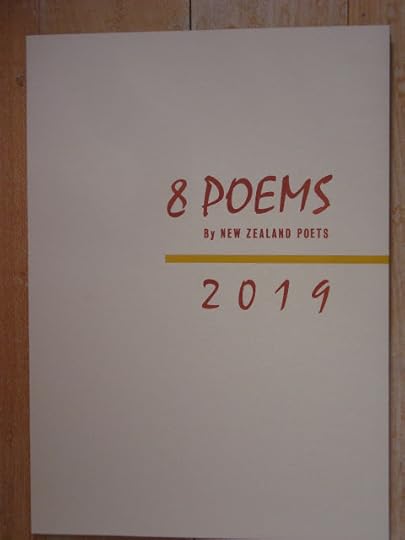
8 Poems by New Zealand Poets 2019
Designed by Tara McLeod (Auckland: The Pear Tree Press, 2019)
Yesterday I received my two author's copies of Tara McLeod's beautiful new chapbook 8 Poems by New Zealand Poets. It's the fourth in the series, earlier editions having appeared in 2014, 2017 and 2018:
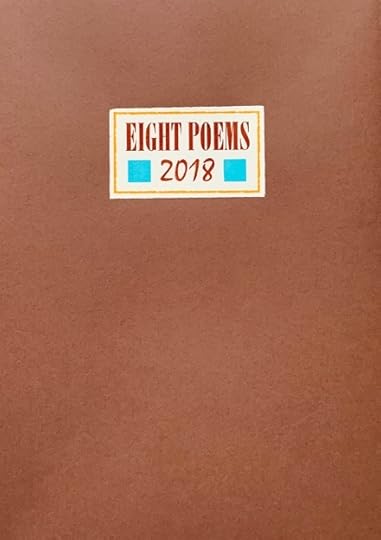
8 Poems 2018

Eight Poems 2017
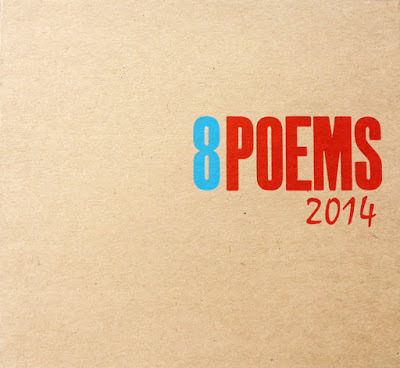
8 Poems 2014
Each book is billed as containing "8 new poems from contemporary NZ poets." It's quite a stellar list. To date the following poets have appeared in the series:
2014:
Riemke EnsingBrian GregoryDavid GregoryJudith HaswellDavid HowardPeter OldsPaul ThompsonDenys Trussell
2017:
Riemke EnsingBrian GregoryJudith HaswellJohn MitchellMichael O’LearyRachel ScottPaul ThompsonDenys Trussell
2018:
Glenn ColquhounRiemke EnsingBrian GregoryRachel McAlpineDaryl McLarenKarl SteadPaul ThompsonRichard von Sturmer
Here's my own poem, 'The Oceanic Feeling,' from the latest volume:
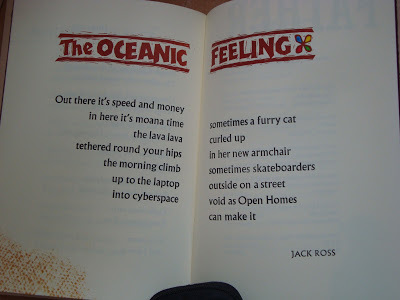
And here's a list, in order, of all the poets included:
Michele LeggottElizabeth Brooke-CarrAlan LoneyMichael HarlowLinda GillJack RossGregory O'BrienPaula GreenRiemke Ensing
Pretty good company to keep, I'm sure you'll agree!
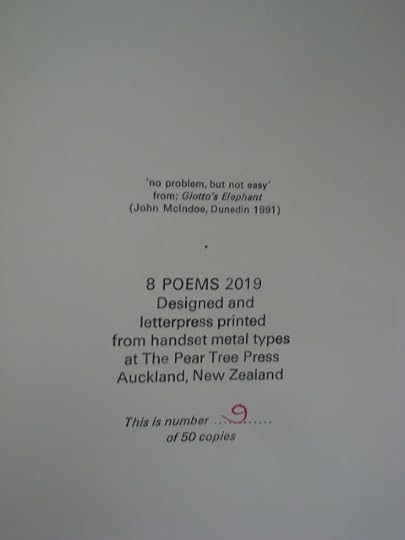
I guess what's most striking about the books is the inventiveness with which Tara has come up with a different design for every poem: with bold colours and variegated font choices to complement the mood of each of them.
I couldn't be happier with the Pasifika look of the title and layout of my own poem, and I'm sure all the other poets feel the same. When Tara showed me a proof of what he had in mind in his studio in Orewa, I was quite blown away. For someone as addicted as I am to handprinting and poetry posters and all those fascinating surrounds to the classic slim volume of verse, it was manna in the wilderness.
I won't disguise the fact: the books are expensive. If you live near a library with a good rare books or special collections section - and which of us doesn't? - you should be able to get your hands on a copy, though (albeit, probably, with white gloves on).
It's always a thrill to collaborate with a real artist, and it's nice to know that Tara is beginning to get the credit he deserves, with a major new book - Tara McLeod: A Typographer's Journey - on his work as a designer, printer and sculptor due out from Lesley Smith's Katsura Press later this year.
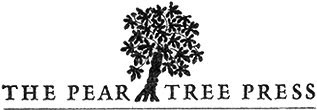
The Pear Tree Press
Oh, and why are there nine poets rather than eight in this particular volume? Through an act of kindness on the artist's part, actually. Elizabeth Brooke-Carr was going to be included in the 2020 volume, but the state of her health made it seem increasingly likely that she'd never live to see it.
Accordingly, Riemke Ensing offered to bow out to give space for Elizabeth in this book instead. Touched by this gesture, Tara decided to include Riemke's poem anyway - there's a note explaining the circumstances beside it.
Elizabeth Brooke-Carr died in her Dunedin home on the 3rd of September, 2019. I don't know if she was able to see her poem in print before she died, but at least the rest of us can.
Entitled 'All that remains is pressed flat,' it's a very moving account of a funeral. Was it Harold Bloom who remarked that elegy was the mode in which poets almost always succeed?

Tara McLeod
Published on September 04, 2019 15:59
August 25, 2019
Craig Harrison (3): Days of Starlight (1988)
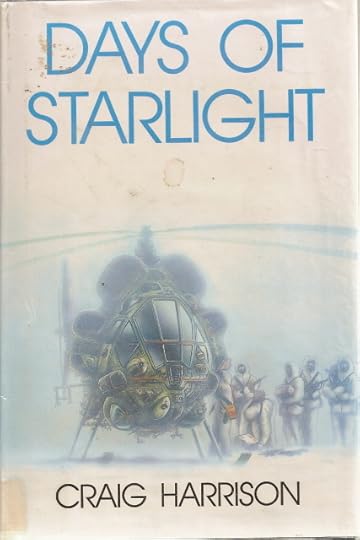
Craig Harrison: Days of Starlight (1988)
Antarctica. A small scientific base. A huge, unexpected discovery made in the ice: something which will alter not just our sense of the history of our planet, but the future of all mankind. Sound familiar?
Of course it does. John Carpenter's The Thing (1982) is, I suppose, the locus classicus for this particular plotline.
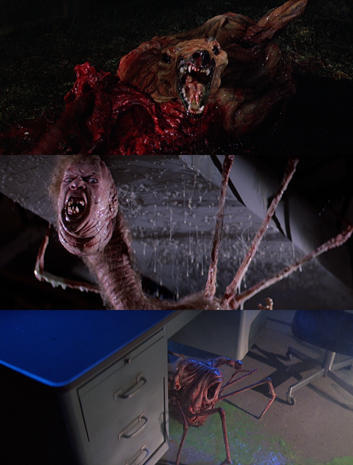
John Carpenter, dir.: The Thing (1982)
The special effects may look pretty hokey nowadays, but I can tell you that at the time they were quite horrifically compelling. Simply coming up with the idea of that severed head with legs scuttling around the base seemed like the kind of out-of-the-box thinking we simply hadn't encountered in horror films up to that point.
Of course there had to be a sequel - or rather a sequel / prequel - The Thing (2011), but it's interesting that they waited thirty years to make it.
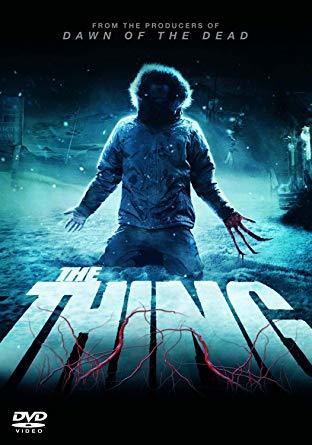
Matthijs van Heijningen Jr., dir.: The Thing (2011)
And when it did come, it was immediately clear that many things had changed. The director is the star of the 1982 film. It's true that Kurt Russell got to run through his usual (slightly ironic) repertoire of heroics, but the film itself did not pander to the accepted conventions of how such things were supposed to run.
By 2011, the system had closed over and healed itself. There was a pretty girl starring - Mary Elizabeth Winstead - who got top billing, and whose oeuvre it tends to be linked to, rather than to that of its rather obscure journeyman director.
All in all, it's hard to see it as much more than a reversion to type. The first film version of the story, The Thing from Another World (1951), though set in the Arctic rather than the Antarctic, sets up its story by the playbook of the standard 1950s alien paranoia film.
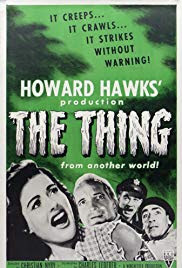
Christian Nyby, dir.: The Thing from Another World (1951)
Of course it's no accident that essentially the same film should have to be remade every thirty years or so. The owners of the rights to a story know that the copyright on their property will expire unless it's renewed from time to time - hence the repeated Hollywood versions of franchises such as King Kong, Mighty Joe Young, The Mummy, The Wolfman, etc. etc.
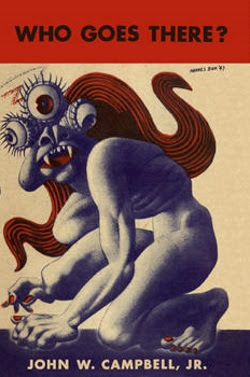
John W. Campbell: Who Goes There (1938)
All three films are based - somewhat loosely, it must be admitted - on John W. Campbell's novella 'Who Goes There?', first published (under the pseudonym Don A. Stuart) in the August 1938 Astounding Science Fiction, of which he was then editor.
An earlier, longer text of the story, entitled Frozen Hell, found among Campbell's papers at Harvard, has recently (2019) been republished on kindle. It was, however, the original version which was voted in 1973 one of the most influential SF stories ever written - just as Campbell himself is (for better or worse) still considered one of the most influential editors of the so-called Golden Age of Science Fiction.
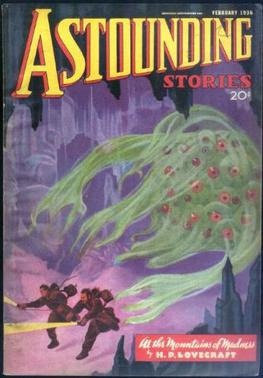
H. P. Lovecraft: At the Mountains of Madness (1931)
Of course, the actual premise of the story - the isolated base in the polar regions (North or South), the frozen aliens in the snow who revive unexpectedly, the desperate struggle for life against them - are all very reminiscent of H. P. Lovecraft's classic novella At the Mountains of Madness, written in 1931, then submitted to his usual outlet, Weird Tales, later that year. Farnsworth Wright, the editor, rejected it for reasons of length, and so, instead, it was eventually serialized in the February, March, and April 1936 issues of Astounding Stories.
Admittedly the story was actually accepted by Campbell's predecessor in the editorial chair, F. Orlin Tremaine. Campbell did not take over till the end of the following year, 1937, but clearly he must have read it, and presumably it influenced his own story.
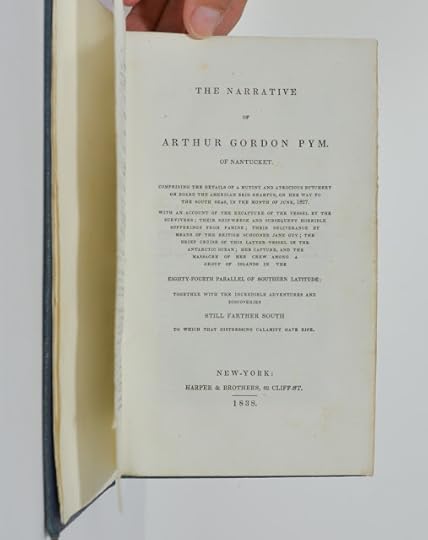
Edgar Allan Poe: The Narrative of Arthur Gordon Pym of Nantucket (1838)
Not that there's any great scandal in that. Lovecraft himself makes no secret of his indebtedness to The Narrative of Arthur Gordon Pym of Nantucket, the closest thing to a novel Edgar Allan Poe ever wrote, and, quite honestly, one of the weirdest and most extreme pieces of fiction ever composed.
Lovecraft ends his own story, in fact, with a direct invocation of Arthur Gordon Pym, quoting the strange cry 'Tekeli-li, Tekeli-li': 'a cry associated with mysterious white-coloured birds and uttered by the natives of the Antarctic land of Tsalal whenever they encounter white objects.'
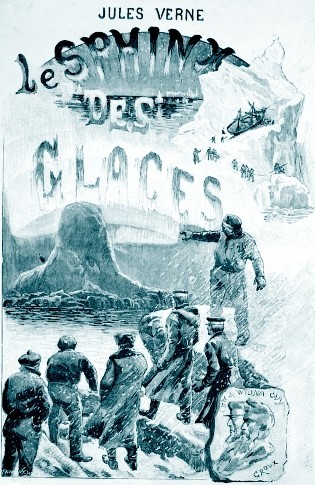
Jules Verne: Le Sphinx des glaces (1897)
The enigmatic ending of Poe's story, with the hero and his companion drifting towards an immense chasm in the (warm) Southern ocean, just as an immense spectral white figure appears before them, is directly addressed in Jules Verne's sequel Le Sphinx des glaces [The Sphinx of the Ice] (1897), translated into English with the rather more prosaic title An Antarctic Mystery.
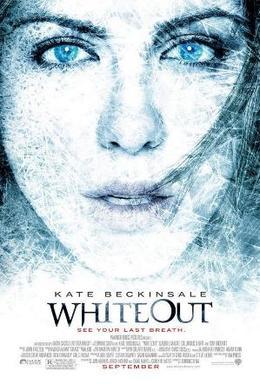
Dominic Sena, dir.: Whiteout (2009)
Once you start looking, It's actually quite difficult to avoid these rather dreamy associations between ice, enigmatic femininity, and dangerous secrets hidden in the preserving cold.
Take, for instance, the 2009 film Whiteout, where Kate Beckinsale - as a rather improbable US Marshall - acts as the involuntary Lorelei drawing large numbers of men to death in their search for the treasure concealed in an old frozen Russian transport plane (it turns out to be diamonds, rather than the fissionable nuclear material she fears it to be for most of the film).
Curiously enough, the French title for this US / Canada / France co-production, Enfer Blanc, translates as 'White Hell' - not too far from Frozen Hell, the original title for Campbell's novel. Plus ça change, plus c'est la même chose, as the French say - or, in Winnie-the-Pooh's paraphrase: "The more it snows, the more it goes on snowing."
•
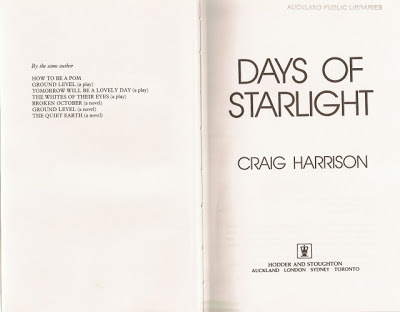
[SPOILER ALERT: reading this part of the post before you've finished Harrison's novel will definitely wreck your appreciation of its dénouement!]
So what contribution does the ostensible subject of this post, Craig Harrison, have to make to this set of various flavours of frozen hell?
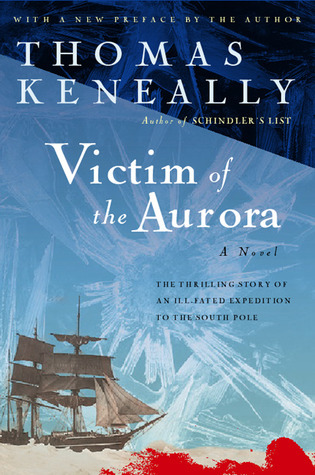
Thomas Keneally: A Victim of the Aurora (1977)
Familiar, undoubtedly, with the John Carpenter film and its various antecedents - though possibly also influenced by some more literary excursions onto the ice, such as Thomas Keneally's 1977 heroic-age-of-antarctic-exploration detective novel A Victim of the Aurora - he takes a rather unexpected tangent.
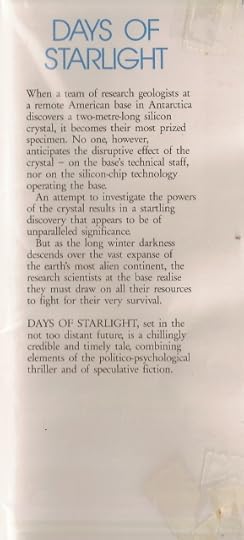
When a team of research geologists at a remote American base in Antarctica discovers a two-metre-long silicon crystal, it becomes their most prized specimen. No one, however, anticipates the disruptive effect of the crystal - on the base's technical staff, nor on the silicon-chip technology sperating the base.
An attempt to investigate the powers of the crystal results in a startling discovery that appears to be of unparalleled significance.
But as the long winter darkness descends over the vast expanse of the earth's most alien continent, the research scientists at the base realise they must draw on all their resources to fight for their very survival.
DAYS OF STARLIGHT, set in the not-too-distant future, is a chillingly credible and timely tale, combining elements of the politico-psychological thriller and of speculative fiction.

There's no doubt that Harrison keeps up the claustrophobia and intensity associated with such narratives every bit as well as any of his predecessors. He keeps the sinister political overtones, too. The 'Delta Force' commandos sent by Washington to wipe out everyone with knowledge of this particular strange discovery in the ice are close cousins to the ruthless 'Blue Berets' in Broken October: sinister armed thugs whose idea of a good time is raping and murdering everyone they encounter.
Almost up to the last page, the story sounds like something which would make a heck of a good made-for-TV movie: clautrophobic (= fewer sets to build and maintain); cold (= bleached-out colours and backgrounds, easy to film); and with a very small cast (= great savings on extras, with more to spend on star power).
But then a basic weirdness, which has been growing throughout, only half-perceptibly, begins to manifest itself. What is the mysterious satellite to which the equally mysterious silicon crystal appears to be linked? It's a kind of transmitter, of course. In function, it's very like the moon monolith in Clarke & Kubrick's 2001 , designed to send a message to some aliens a long way off just as soon as the inhabitants of this particular rock have reached a sufficient stage of development to warrant it.
I say 'warrant' rather than 'deserve' it because the whole book is about just what we deserve. And by 'we' I mean any and all beneficiaries of European hegemony. 'What if the aliens came and they were black?' is Harrison's basic question.
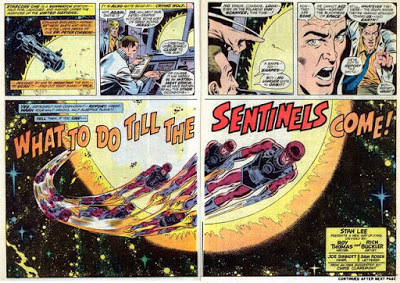
Roy Thomas: Avengers #102 (1972)
The crystal has been keeping an exact holographic of - everything, you see. The aliens will only need to look through it to see just what we've been up to, and it won't be a pretty sight. The book ends with Ben the protagonist's realisation that we have approximately 30 years to clean up our act - that's how long it will take them to get here, travelling at near light speed. 'What to do till the sentinels come,' to quote the title of a classic Marvel comic.
Is there a certain element of bathos in all this, after so much build-up, so much tension, so much spy-thriller intrigues? There certainly shouldn't be: it's a most ingenious solution to the narrative problem of how to find a new twist on the old Antarctic base story, but somehow there is. Turning it into yet another iteration of the conundrum black-white race relations seems just a little forced after Harrison's far more straightforward engagement with it in Broken October, and even the more effective, albeit fantastical and dreamlike extension of that in The Quiet Earth.
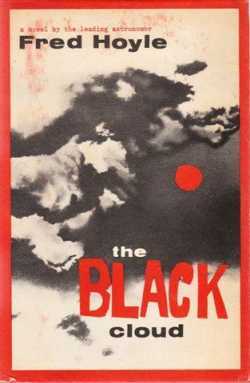
Fred Hoyle: The Black Cloud (1957)
But perhaps, in the end, that's the point. Days of Starlight may not work perfectly as a thriller (à la Whiteout or The Thing). Nor does it really succeed in emulating some of its more strictly Science Fictional influences: Fellow-Yorkshireman Fred Hoyle's classic The Black Cloud (1957), for instance, for the alien intelligence; or Stanisław Lem's His Master's Voice (1968) for the baffling artefact from another world (in Lem's case, a line of code in a book of random numbers which turns out to have been generated by the transmissions from a certain part of space).
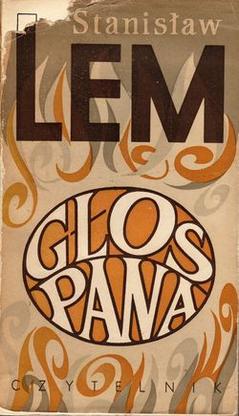
Stanisław Lem: His Master's Voice (1968)
I suppose, in the end, that's what makes it - for me - an exemplary piece of New Zealand Speculative Fiction. Insofar as this can be seen as a genre at all, it tends to involve a certain rejection of cosmic solutions and speculations in favour of more nitty-gritty, number-eight wire, alternatives.
Sentient oceans and hyper-intelligent clouds are all very well, Harrison appears to be saying, but we've made a terrible mess of the place and the people who are actually here, all around us. Let's make a full acknowledgement of what it is we've done, as a first step in the process of repairing it. It falls almost naturally into the wording of the Alcoholics Anonymous 12-step programme.
We: Made a searching and fearless moral inventory of ourselves [Step 4] Made a list of all persons we had harmed, and became willing to make amends to them all [Step 8] Made direct amends to such people wherever possible [Step 9]As such, I think Days of Starlight must be seen as a worthy culmination to the SF trilogy Harrison began with Broken October (1976) and continued in The Quiet Earth (1981).
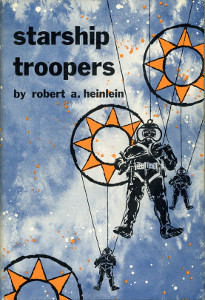
Robert A. Heinlein: Starship Troopers (1959)
It falls in line more with the preoccupations of writer / critics such as Samuel R. Delany - who famously argued that the protagonist of Robert Heinlein's Starship Troopers must be black - and Ursula K. Le Guin, the hero of whose Earthsea books, Ged, was always intended to be dark-skinned, though he's seldom been portrayed in that way in cover illustrations - than with more familiar SF tropes and themes.
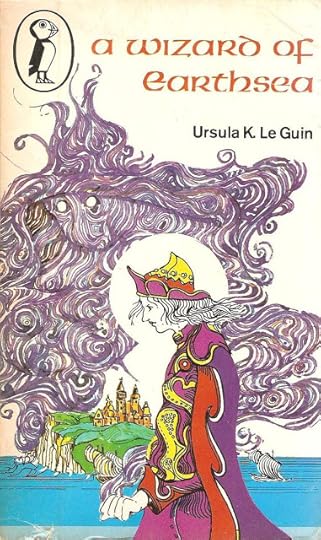
Ursula K. Le Guin: A Wizard of Earthsea (1968)
But, once you start looking for it, the subject of racial prejudice intrudes everywhere: in Isaac Asimov's "robot" saga; in many other manifestations of the Android theme (such as Stanisław Lem's Solaris (1961), filmed so memorably by Andrei Tarkovsky (1972); or - for that matter - Philip K. Dick's Do Androids Dream of Electric Sheep? (1968), the inspiration for the 1982 film Blade Runner).
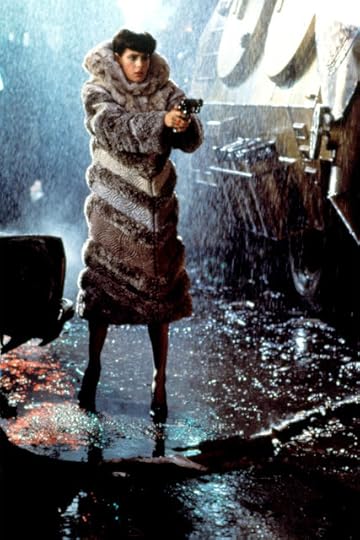
Blade Runner (1982)
So what's the problem, then (if there is a problem)? I suppose, for me, it lies in the implications of Harrison's contention, throughout the novel, that black and white people's brains do indeed work differently, and are based on a different design. This manifests, for instance, in the greater amount of REM sleep required by the black, mostly service people on the base.
It turns out in context that this is a sign of superiority, not inferiority - and the racist assumptions to the contrary of the base's chief doctor, Kellner, are thoroughly satirised in context.
It's just that - even in the context of a quite far-fetched piece of speculative fiction, entertaining such ideas of a fundamental difference seems a dangerous one (Ben, the protagonist, turns out to be tuned in to the alien satellite's transmissions, communicated through dreams, thanks to the fact that his great-grandfather was in fact black - he therefore escapes the tone-deafness of the other honkies in the story).
It's not that Harrison is unaware of this peril. There's a passage early on where Ben and his love interest, Linda, talk about Dr. Kellner's research as follows:
'Well, if people like Kellner can prove that blacks have got inferior brains, then it means that they needn't worry too much about what the West has done in the last couple of hundred years. And goes on doing ...Har-de-ha-ha. The trouble is, this isn't all that far from the actual underlying thesis of the novel. It's a little like the anthropologists who've postulated at various times independent lines of descent for Australian Aborigines and other native races from those which produced the Caucasian master race.
'And this cerebrum makes us superior?'
'He reckons it's the centre of our rationality.'
'And the cerebellum's the opposite?'
'Yes: and much older. More primitive, he'd say. Controls all the magical, dreamtime, intuitive, visionary perceptions.'
'And the marvellous sense of rhythm.' [35]
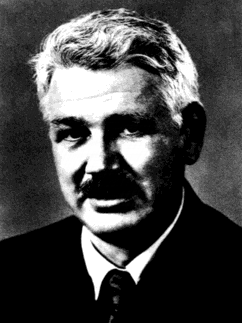
Carleton S. Coon (1904-1981)
The most notorious of these is undoubtedly the unfortunately named Carleton Coon, whose notorious book The Origin of Races (1962) argued:
that the human species divided into five races before it had evolved into Homo sapiens. Further, he suggested that the races evolved into Homo sapiens at different times.Coon claimed that he had been prompted purely by a desire to follow the evidence where it led, but many of his contemporaries saw this idea as providing fuel for white segregationists and racists generally. Was Coon himself a racist? He, and most of his colleagues, have continued to deny the suggestion indignantly.
I did once see a documentary on the subject, though, where one of those colleagues summed up his feelings more or less as follows: he said that Coon had travelled to every corner of the globe, had met people of all races, worked and interacted with them, and lived among them. Many of them had become his close friends. And yet, he concluded, "I don't think for a moment that it ever occurred to Carleton S. Coon to regard any of them as his equals."
Craig Harrison - in his fiction and in his life - is a positive zealot for racial justice. This book of his is no exception. His fictional Dr. Kellner and the real-life Professor Coon would be seen by him as close intellectual cousins. But his book does have a tendency to encourage 'separate but equal' thinking about the various races of mankind.
It would be a real shame to dismiss his book unread on the strength of that, but I think that it does offer some explanation as to why so eminently filmable a story has remained untouched by directors ever since.
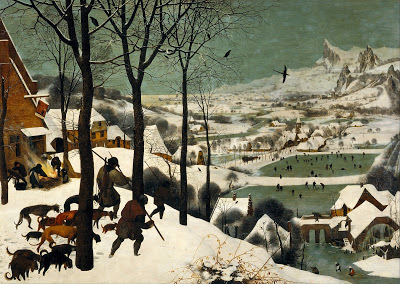
Pieter Bruegel: Hunters in the Snow (1656)
- a thematic reference in Tarkovsky's Solaris
•
Published on August 25, 2019 13:56



